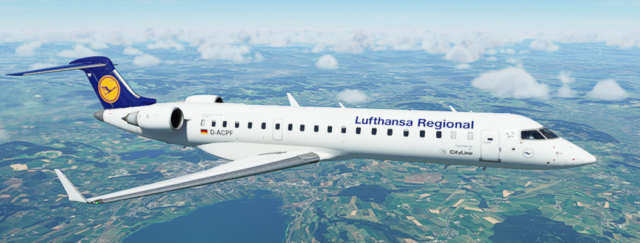
The first system-deep jet in the new Microsoft Flight Simulator has landed, pretty much exactly 7 months after the platform’s release. We had the opportunity to test a very late pre-release version, provided to us by Aerosoft. Our claim is to provide you with solid information about addons, but in this particular case, also to give you this information as soon as possible. Therefore, we decided to try something we haven’t had for a long time: a dual review, so we can share out the work a bit. We hope to be able to contribute to your purchase decision with our article.
Some preliminary remarks:
- The airplane is referred to in this review as the CRJ. This is actually not quite correct, but is consistent with common usage. We are thus consistent with the Wikipedia article.
- This article is a translation from the original German article on simFlight. de, and it does not take the first update into account. The change list of version 1.0.0.1 at least does not mention the small bugs we identified in the last section.
- We are no native English speakers;).
The real CRJ 700 and 550 (Michael)
Aerosoft’s CRJ has a history – it had taken seven years of development until August 2017, when the short-haul jet that was so dearly longed for by the scene (and repeatedly announced) appeared – still for FSX and also already its successor P3D. That this aircraft now appears as the first complex airliner for the MSFS is charming!
The real-life prototype was developed in Canada at Bombardier in the late 80s, at the suggestion of Lufthansa and as a development based on the Challenger business jets. The first flight was in 1991, and the entry into service of a total of 226 CRJ 100 aircraft for 50 passengers with a range of 1,815km followed from 1992, mainly by Lufthansa. They were soon superseded by the CRJ 200 with improved engines and thus longer range, 709 of which had been sold by 2018.
A stretched and revised version, the CRJ 700 (first flight in 1999, in service from 2001 and active with Lufthansa Cityline until 2014) accommodated 75 passengers and 2,553km range, the ER and LR variants with larger tanks and heavier weight up to 3763km. The CRJ700ER was implemented by Aerosoft for the MSFS. Based on the 700, Bombardier developed the CRJ550 for United Airlines – only 50 seats (30 of them first and business class) and lower weight – to circumvent requirements in American collective bargaining agreements. 50 units were delivered to the States. This model is also found in the Aerosoft package.
Once again, a stretched version was launched in 2001, the CRJ 900 for up to 90 passengers, and again it was Lufthansa that provided the breakthrough as the initial orderer, 215 aircraft were sold in total, 34 are still in service with Lufthansa today. In 2010, another version of the CRJ 1000 entered service, lengthened by nearly 3 meters to accommodate 104 passengers, with a lowered cabin floor, enlarged windows and larger wings; the 900 was now considered a too narrow tube by passengers. By this time, however, the competing, newer Embraer 145 and 190 models were making the CRJ look “old,” especially in terms of operating costs. The CRJ was no longer profitable to market, despite the uplift, and Bombardier added $2 million on top of each aircraft produced (about $25 million in sales price). In 2019, Mitsubishi bought out the manufacturing with all patents and delivered aircraft still on order. On 2/28/21, only some weeks ago now, the last CRJ produced rolled out of the hangar (see here). About two-thirds of the 1,945 CRJ jets built went to the Americas, and about one-third went to Europe.
As in real aviation, the CRJ fills a real gap in MSFS: it is used to fly to small, fine airports, and the CRJ is popular for flying short after-work city hops.
What does it look like? (Michael)
The long history of development is paying off – the CRJ is designed down to the finest details and is visually convincing as “first class”. The walkaround:
Open the door (great, you can’t do that with the standard MSFS jets “just like that”) and get out of the cockpit … the fine details of the stairs already put you in a good mood. The inspection at the nose too – all pitot tubes, statics, sevice doors, AoA sensors, ice detectors, ports are designed, the markings are high resolution, as well as the nose gear, there is everything on it that belongs to it. Wipers, lights, also antennas and outlets under the belly, the details of the baggage hatch flap, the fuel filler flap, every rivet counter is thrilled. Alexander Gerst (German ISS astronaut) was warned not to study aerospace engineering – he would then spend the rest of his life designing block door handles for Airbuses. It must have been something like that with the CRJ’s landing lights – the recreation in the Aerosoft model even includes the high-voltage warning signs hidden behind windshield glass. What doesn’t work (an MSFS bug, because I noticed this on the MB399 as well?): that lights which are turned on also do glow from a short distance. You can see the light effects on the aircraft and on the ground, but no bright headlights, they stay “off”, only from a distance they shine too.
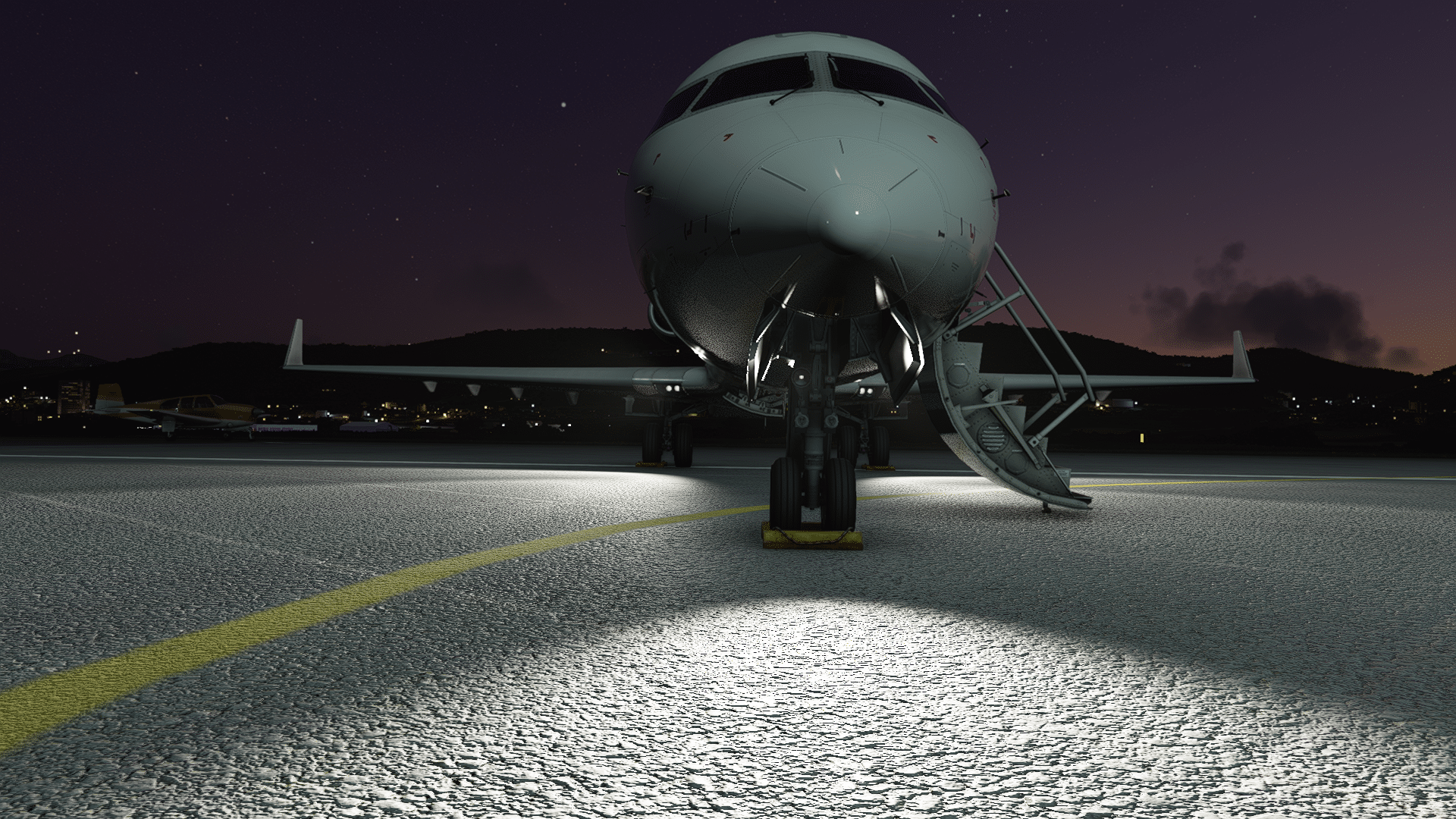
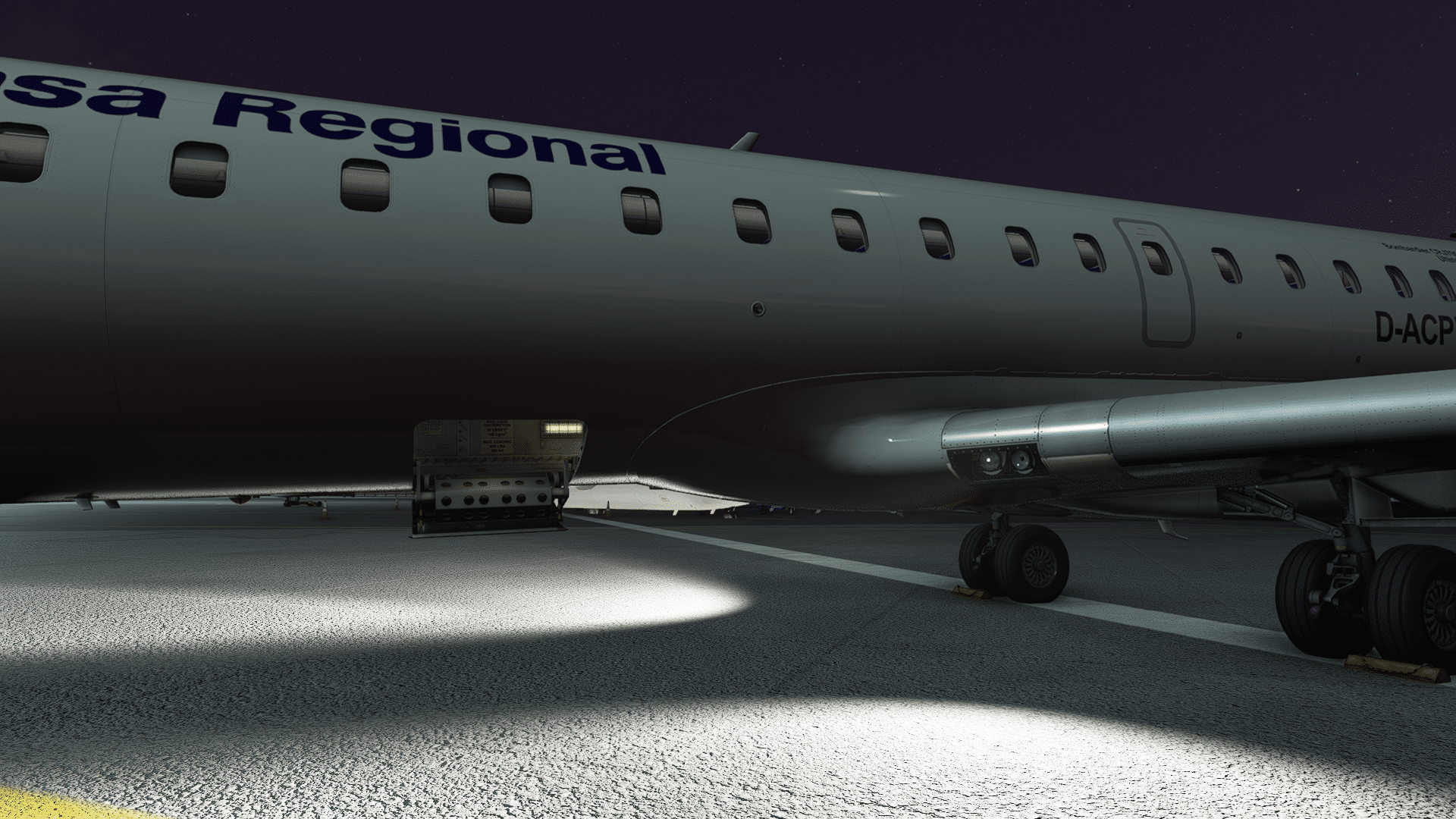
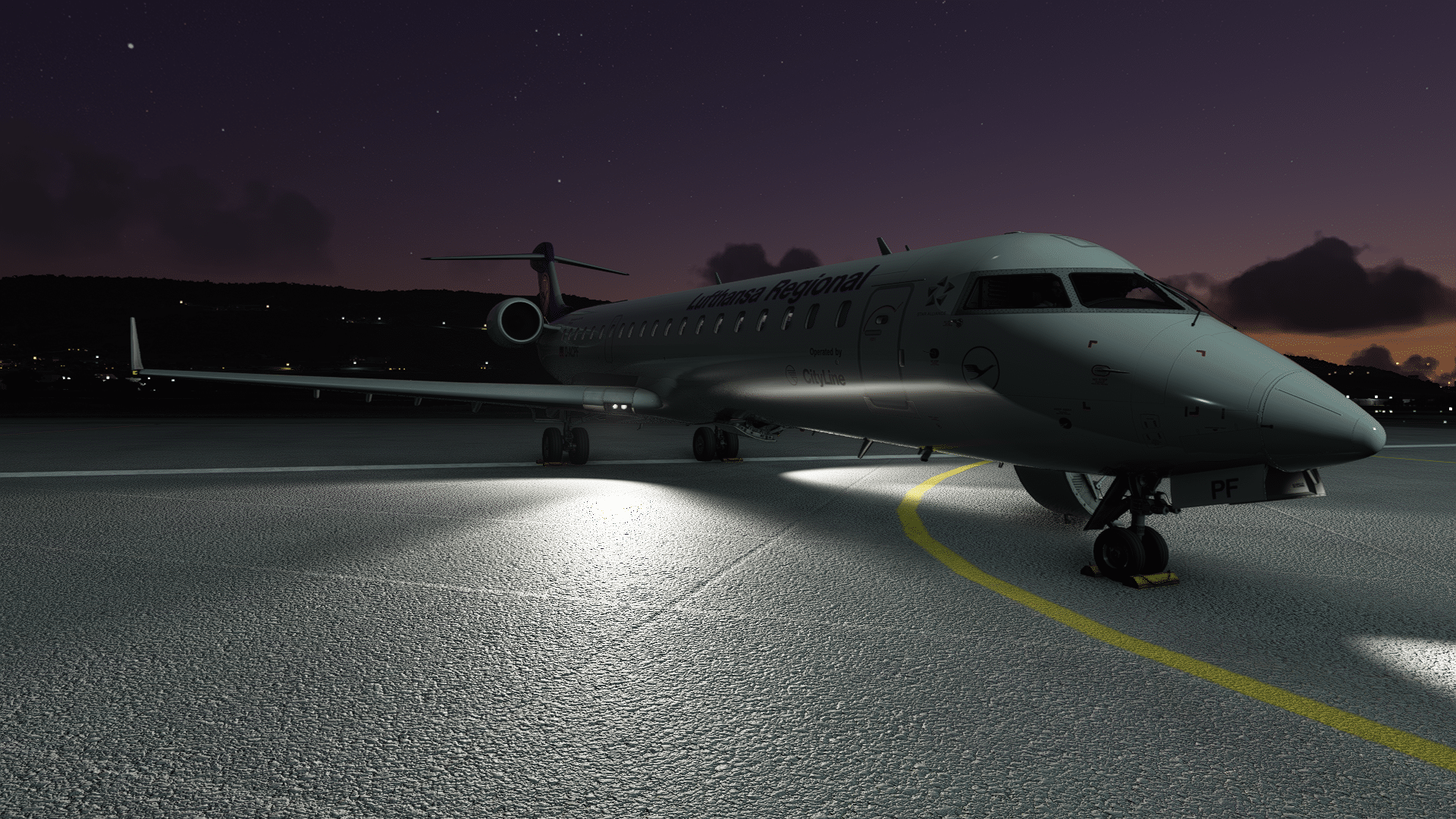
There is nothing to complain about on the right main landing gear, all lines and even the brake disks are shown. Also when looking into the landing gear bay: “thumbs up”. Up close, it becomes clear what my editor colleague meant by “angular” in the first impression (only available on the German site) – the actually round components are programmed as polygons. If that helps the fluidity of the process – I’m happy with that! We are not simulating maintenance on the landing gear, but flying. In case the designers want to get more detailed in the future: there is a pin on each wheel that shows the wear of the brake pads at a glance, they are part of the mandatory program for the walkaround.
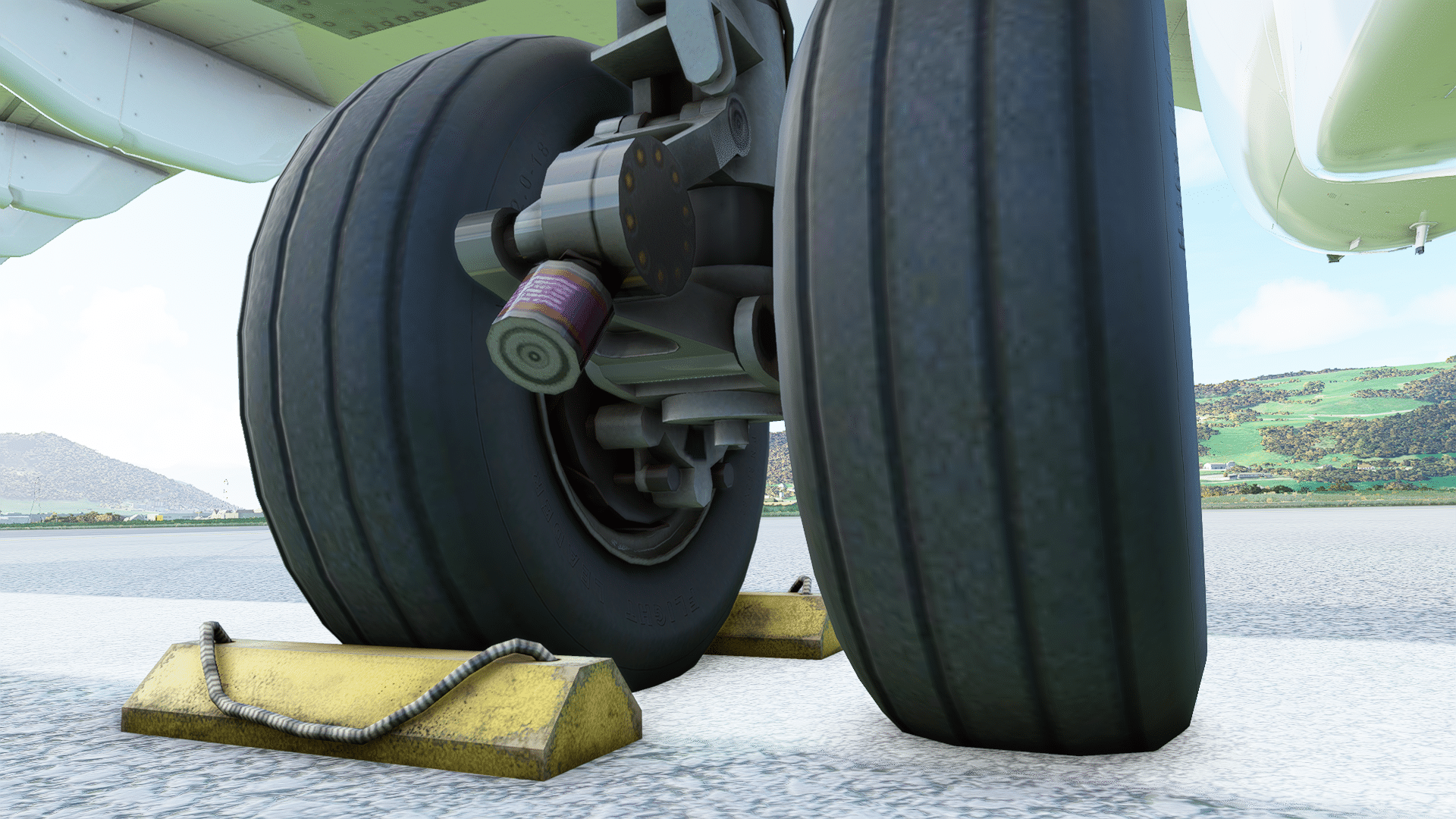
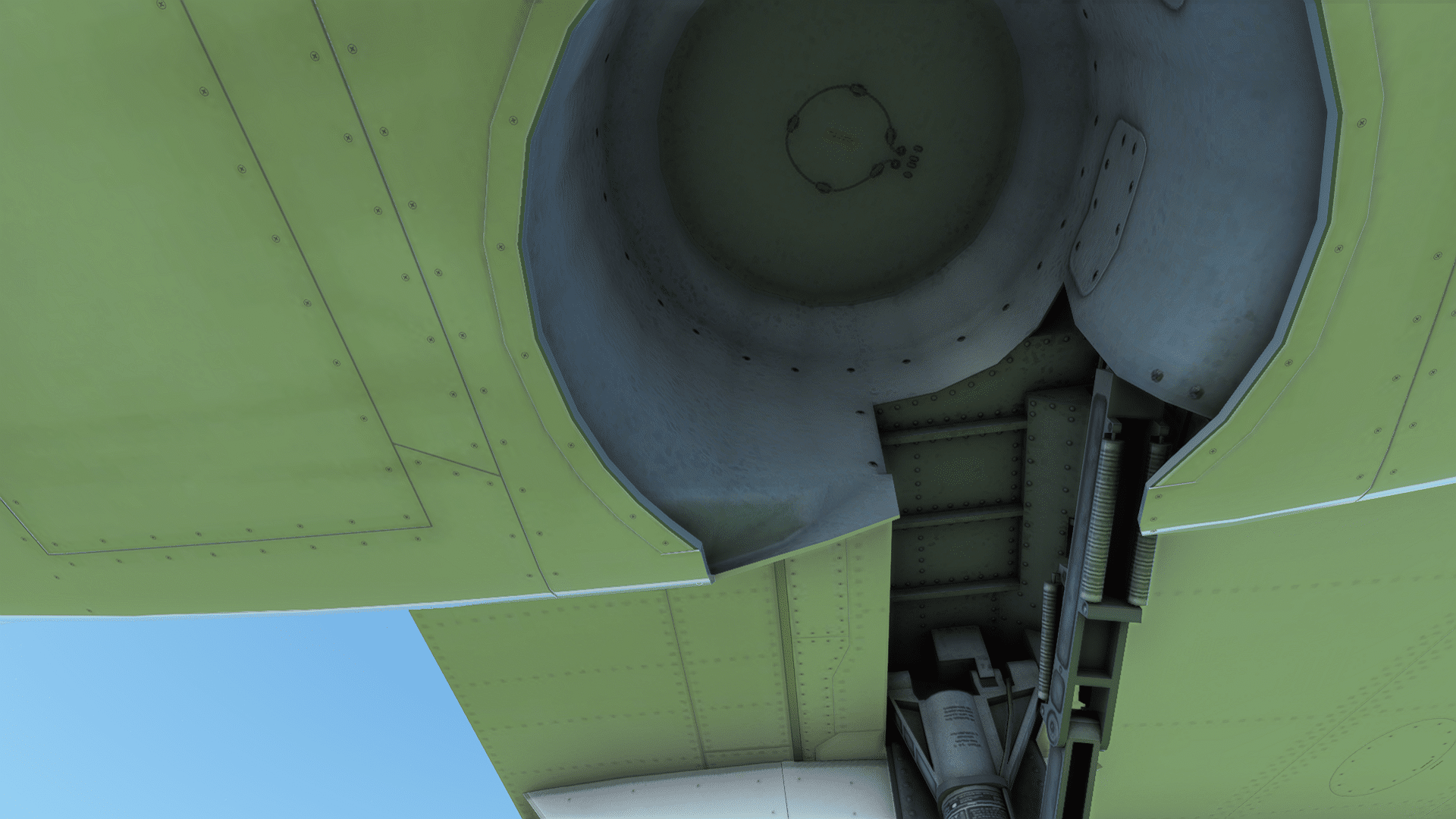
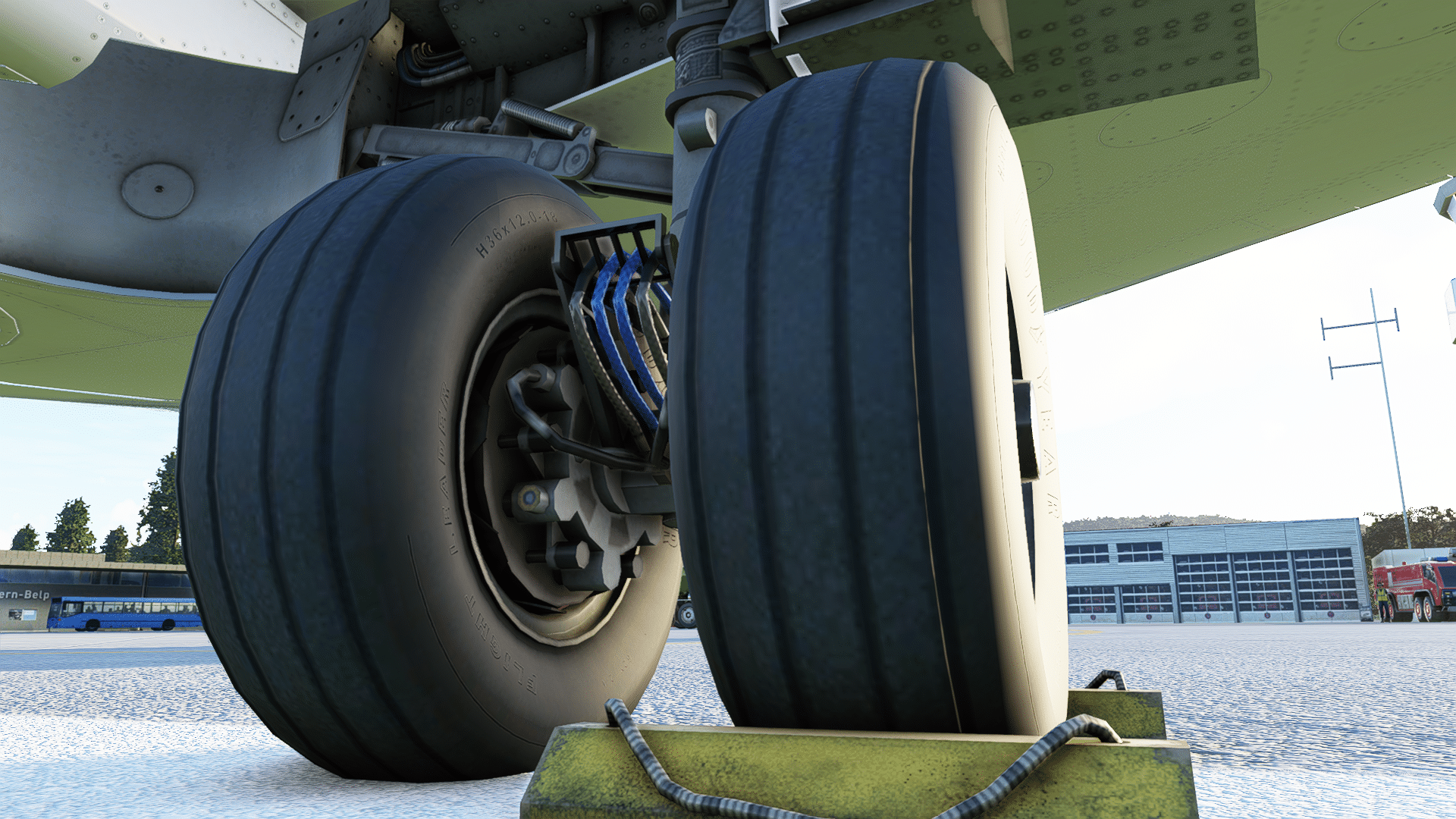
The leading edge of the wing comes across authentically (even with the slats extended it looks real, nothing like graphic shortcuts). The wingtip is similarly detailed with all its lights like the landing lights. The trailing edge of the wing is sharp, even with the flaps extended it all looks very realistic, just “like the real thing”, and the static wicks are there too, designed to dissipate electrical charges into the air.
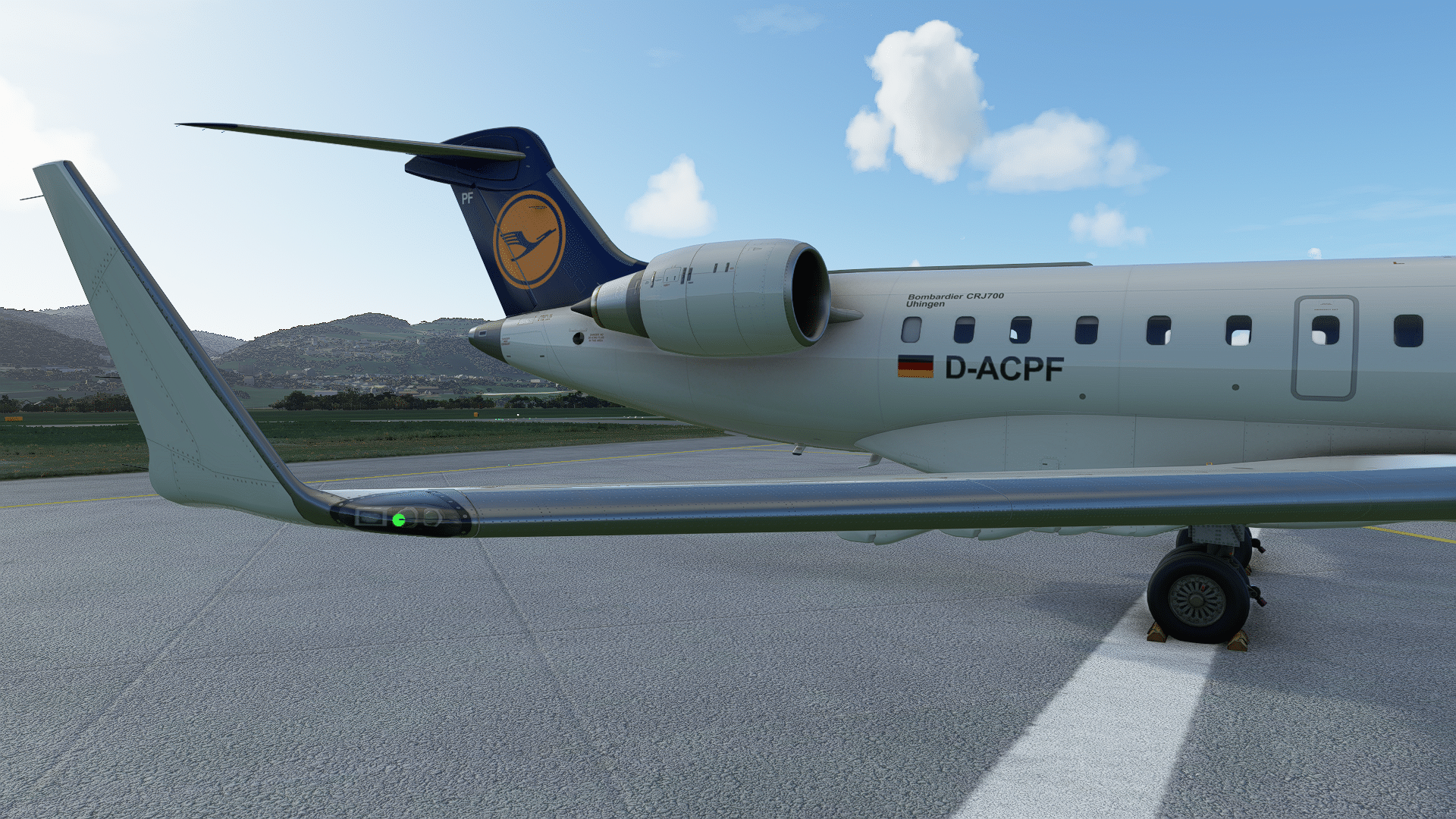
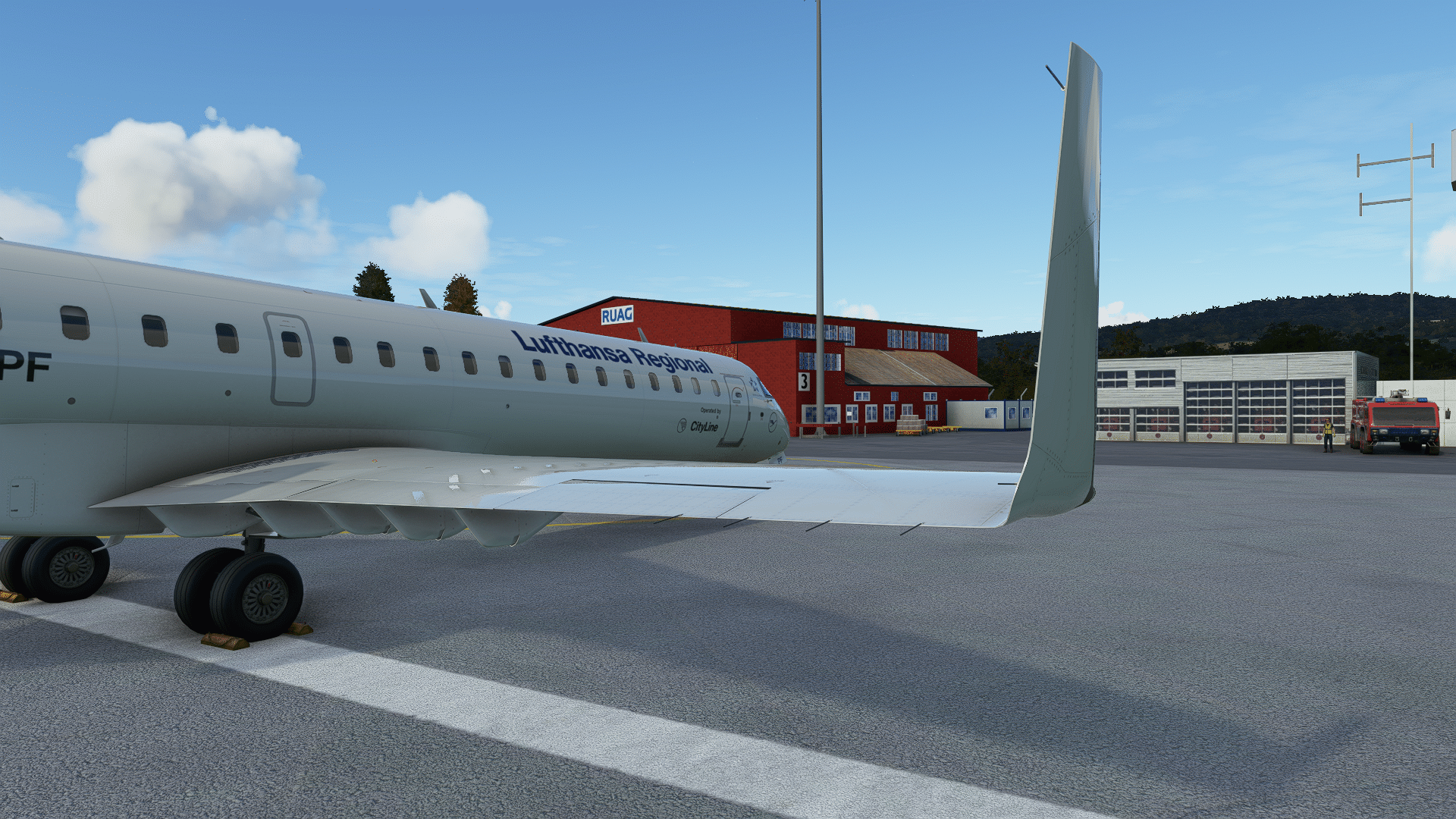

When it comes to the markings on the rear fuselage, there is some disappointment – they are strangely pixelated, which disturbs the otherwise so precise impression. This should actually work better, but at best it justifies deductions in the B grade, because it is rarely so close that it is noticeable.
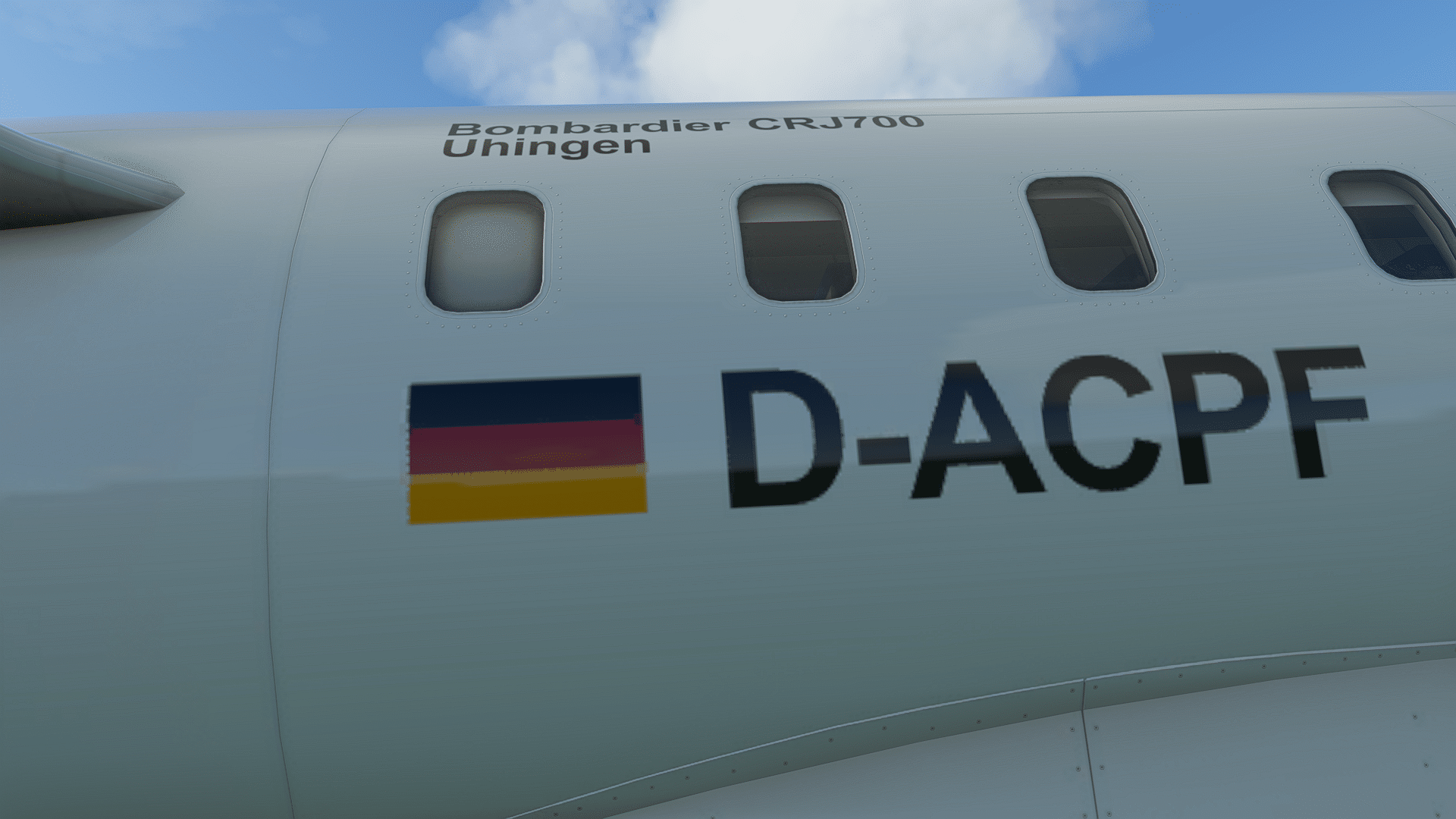
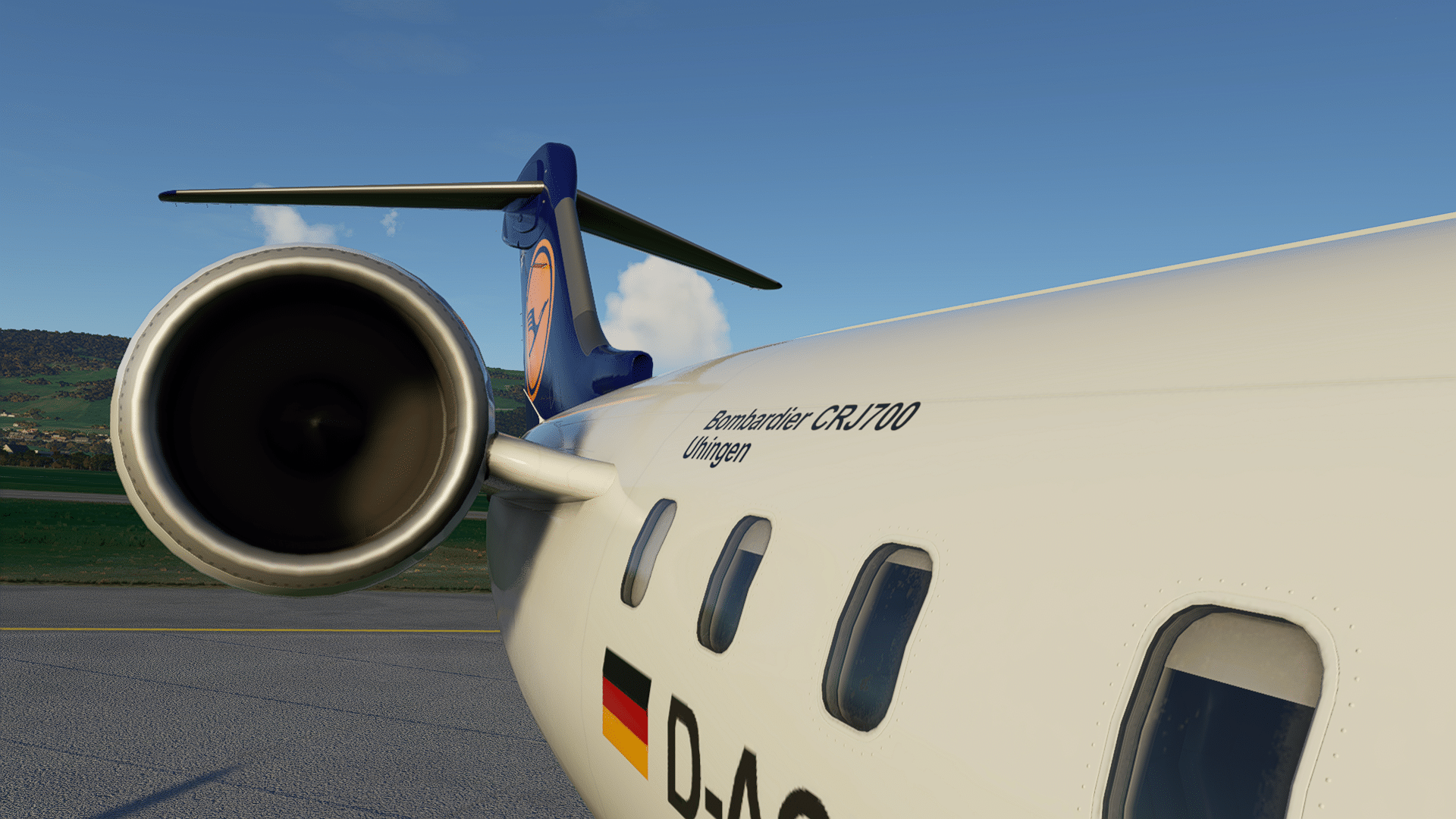
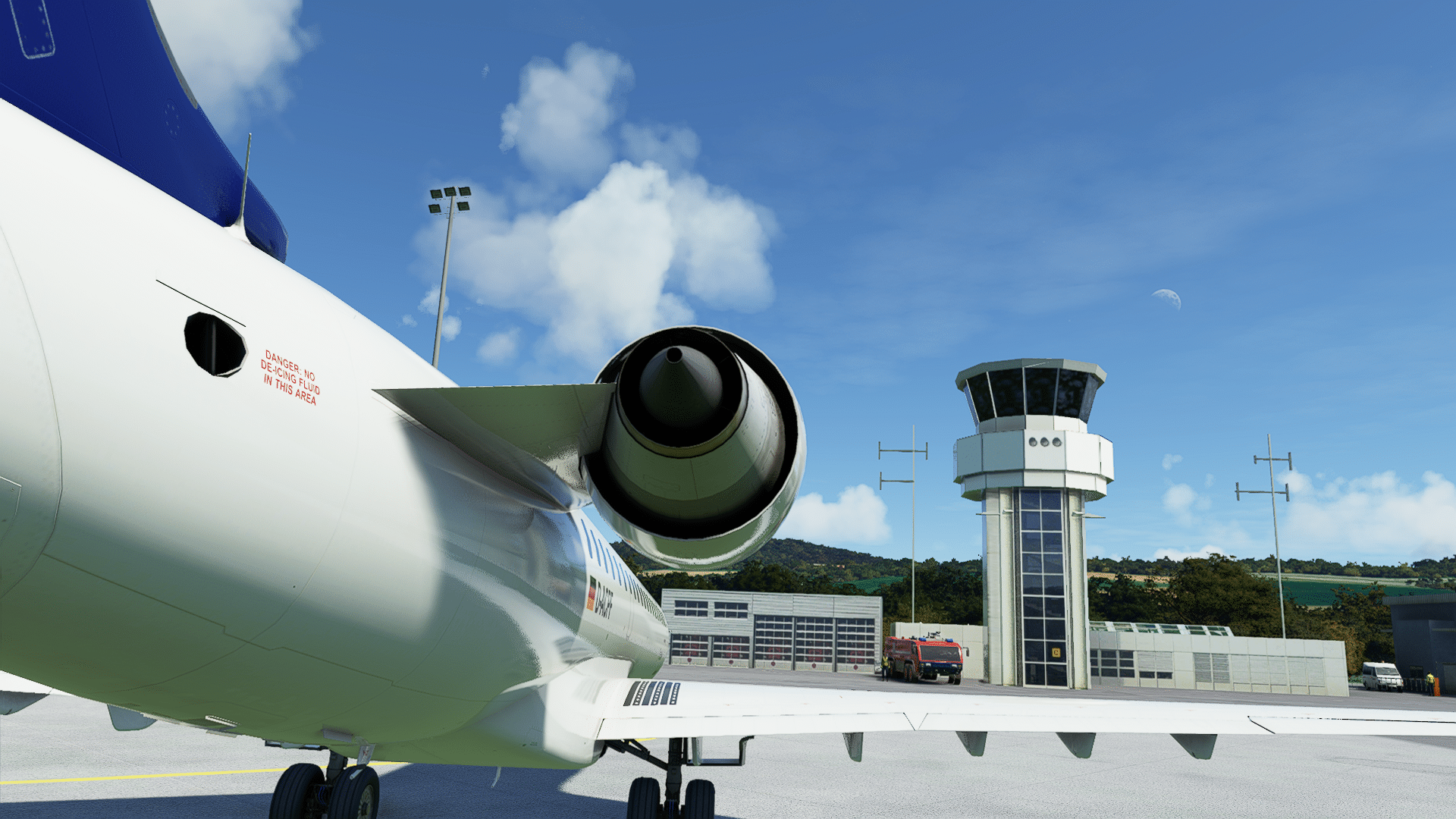
A look inside the engines … and again a disappointed “Oh”…. you don’t see fans, but a moving washed out texture that looks similar to a running engine. We are on the ground, the APU is running but the engines definitely are not. On large aircraft with prominent turbofans, like the Airbuses or Boeings, this would be a no-go in MSFS. The CRJ engines are so close to the fuselage and further up, above the wings, that there are hardly ever “natural” perspectives on the standing fans, so in this respect the omission is not a very serious mistake. In view of the otherwise so detailed implementation, the sparseness at this point is surprising, it does not fit into the overall picture. The jet pipe looks good again.
At the rear, the CRJ again shows what the designers at Aeorosoft are capable of – the flap for the APU to grab air has opened dutifully, the tailskid, all inlets, outlets and antennas and also razor sharp small lettering, and typical for the 700 the APU exhaust aft … everything is right here.
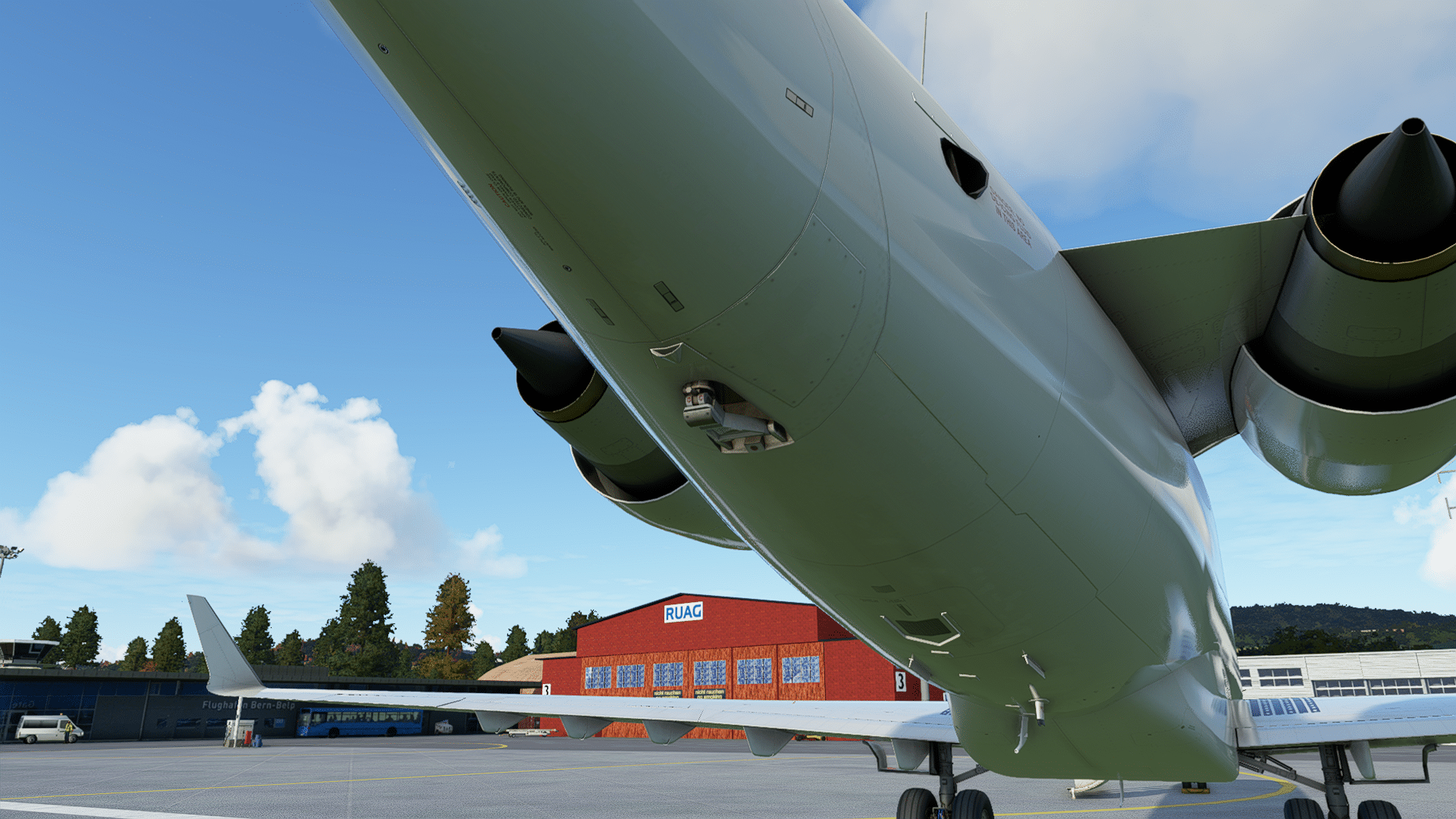
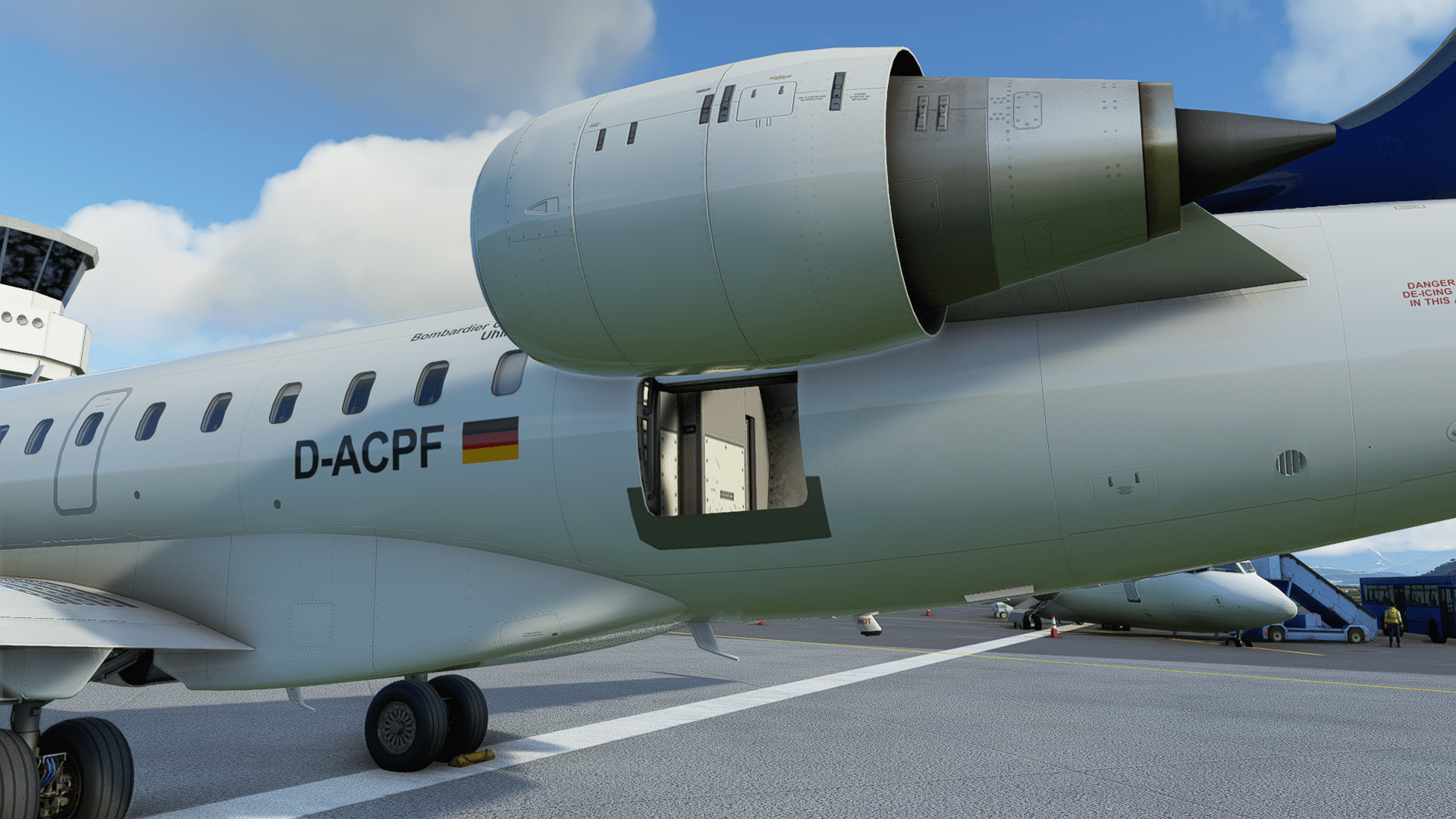
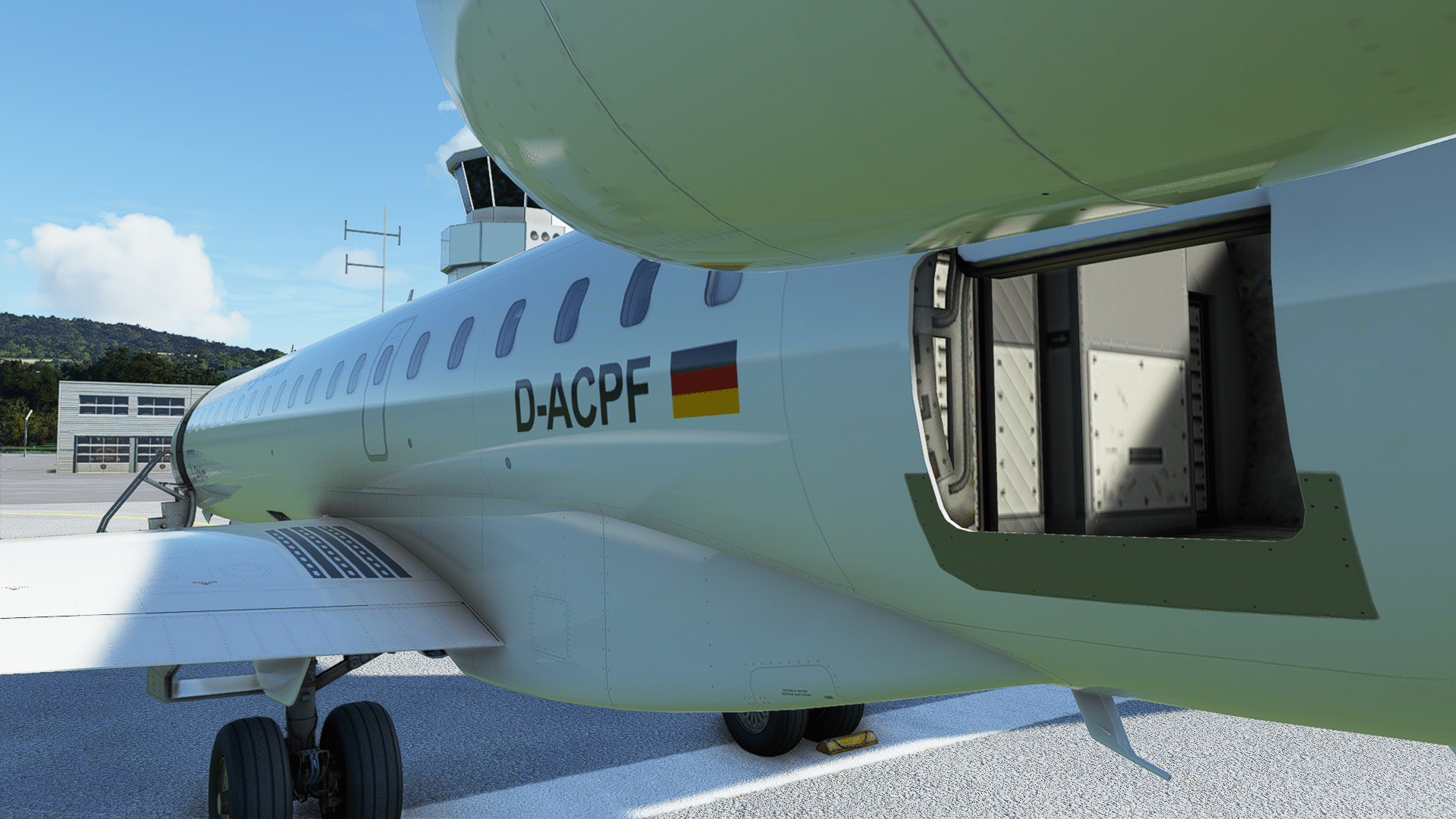
The left engine also shows no fans, then ew have a look at the baggage hatch and the (more coarsely resolved) interior of the baggage compartment, the wing edges on the left with winglet, the left landing gear, flaps, outlets, lights, all just as precise as on the other side. One is satisfied and pleased with the accuracy, finally you can really see something of the aircraft technology on the outer skin.
For those who want to see such a walkaround from real life:
Let’s take a look inside. A quick look – yes, not only the cargo compartments, the passenger cabin is modeled as well, albeit simple, one class fits all. But still. Irrelevant for the simulation as a pilot in the flight deck, you want to sit right at the front. Other providers had even modeled aircraft toilets (with functions), as a joke ok, but who needs something like that? Here Aerosoft has saved in my opinion in the right place.
So right to the front … and sit down. With Track IR, it immediately conveys that this used to be the dimension of a business jet, now packed with airliner technology – it’s cramped. It’s a good thing that the user is not simulated – one constantly would receive collision reports. And something else is noticeable…such a familiar “Aerosoft” feeling, as you know it from the FSX airliners for example, something about the graphics has a “stable smell”, at least these are not photo surfaces with wear marks, but computer textures. The cramped quarters are also noticeable “during working” – the screens are quite small (though informative), you have to lean way over to read. And the many buttons, cogs, levers are close together and they are small. The CRJ is something for good eyes and for pianist hands. Aerosoft can’t do anything about that – on the contrary, the feeling comes across very well. The operation is then also delicate… you have to look very closely, and use the mouse precisely to hit the right cog and then turn it in the right direction. Unfortunately my VR-Insight-Panel doesn’t work for Aerosoft’s CRJ, that would make a lot of things easier (and surely there will be help from the community soon). This CRJ is just not a “sit in and fly away” addon, it needs to be worked out. You have to get used to it.
This already starts with the lighting…until you have found all lamp switches and controls, you search for a while (and find something new every now and then). The cockpit illuminates then however very cozy. Whether with daylight or artificial light: everything is cleanly modeled, even when zooming in cleanly labeled. Nothing falls down to blurry pixels, the work has been done very well, even in places you rarely look at, like the fuse strips! Simply beautiful, that’s how you want an airplane on optical MSFS level! If you look closely at the highest zoom level, you can again see small corners on the round cogs, wires, etc. … but in normal operation this is not noticeable.
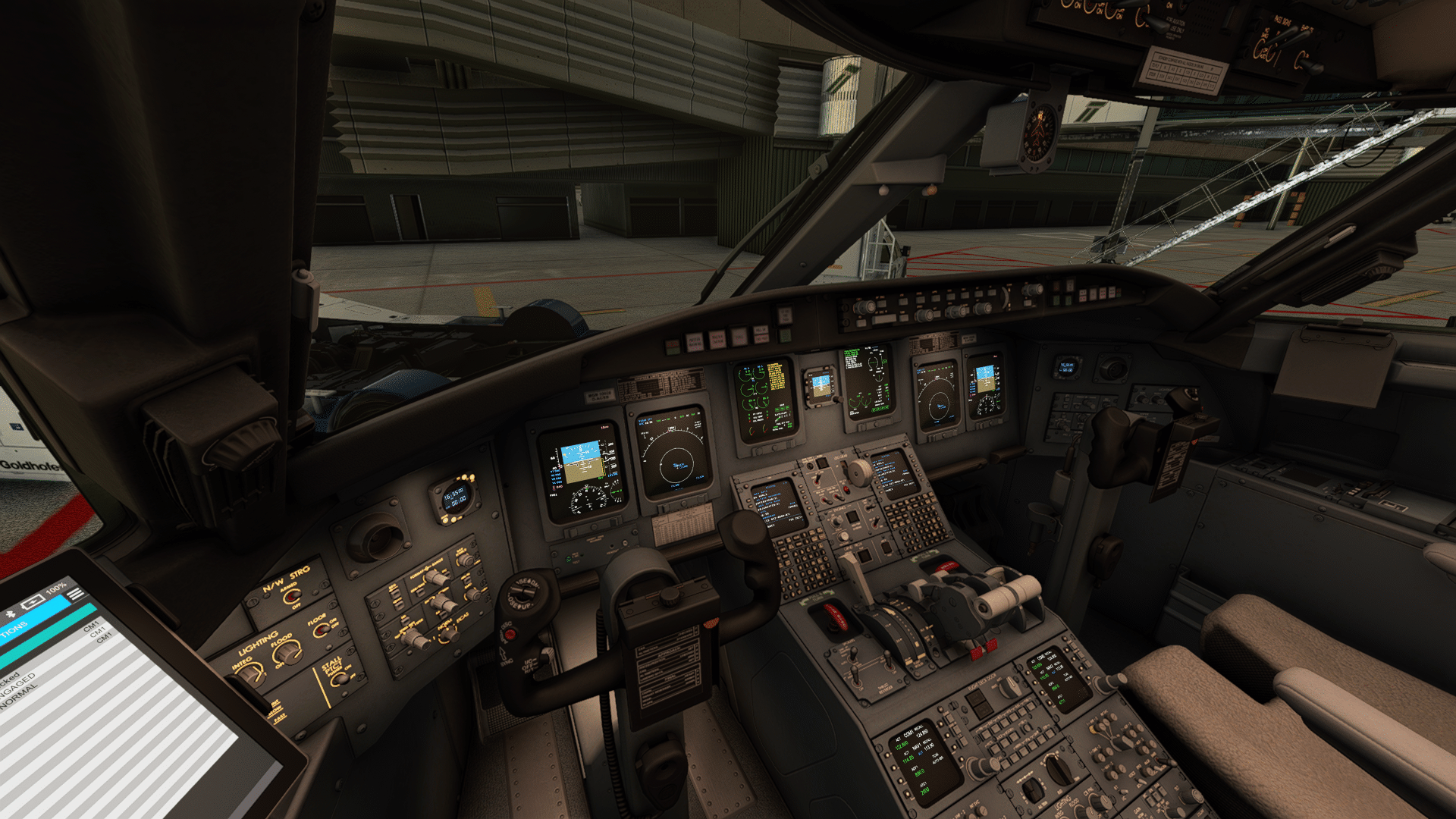
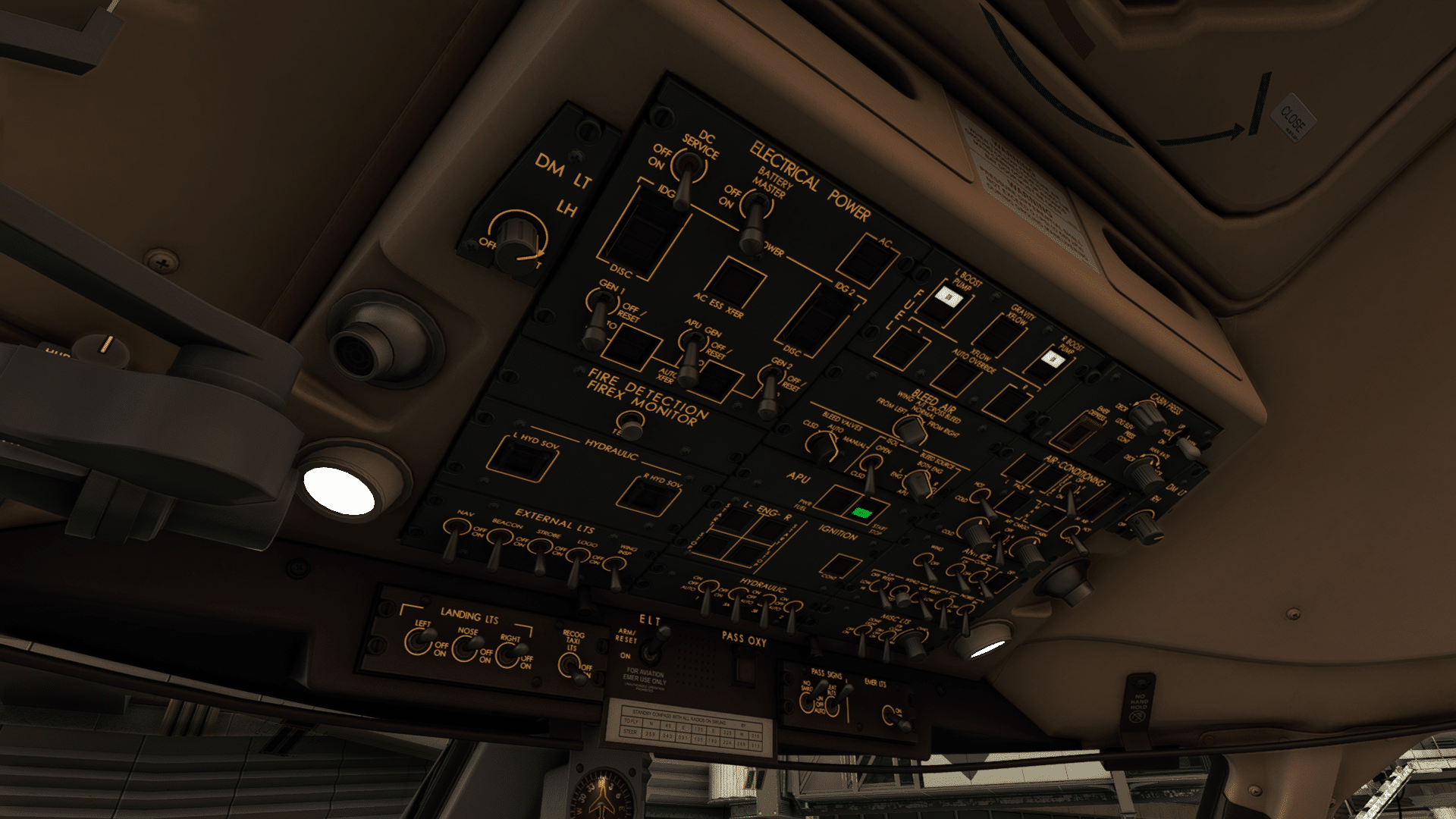
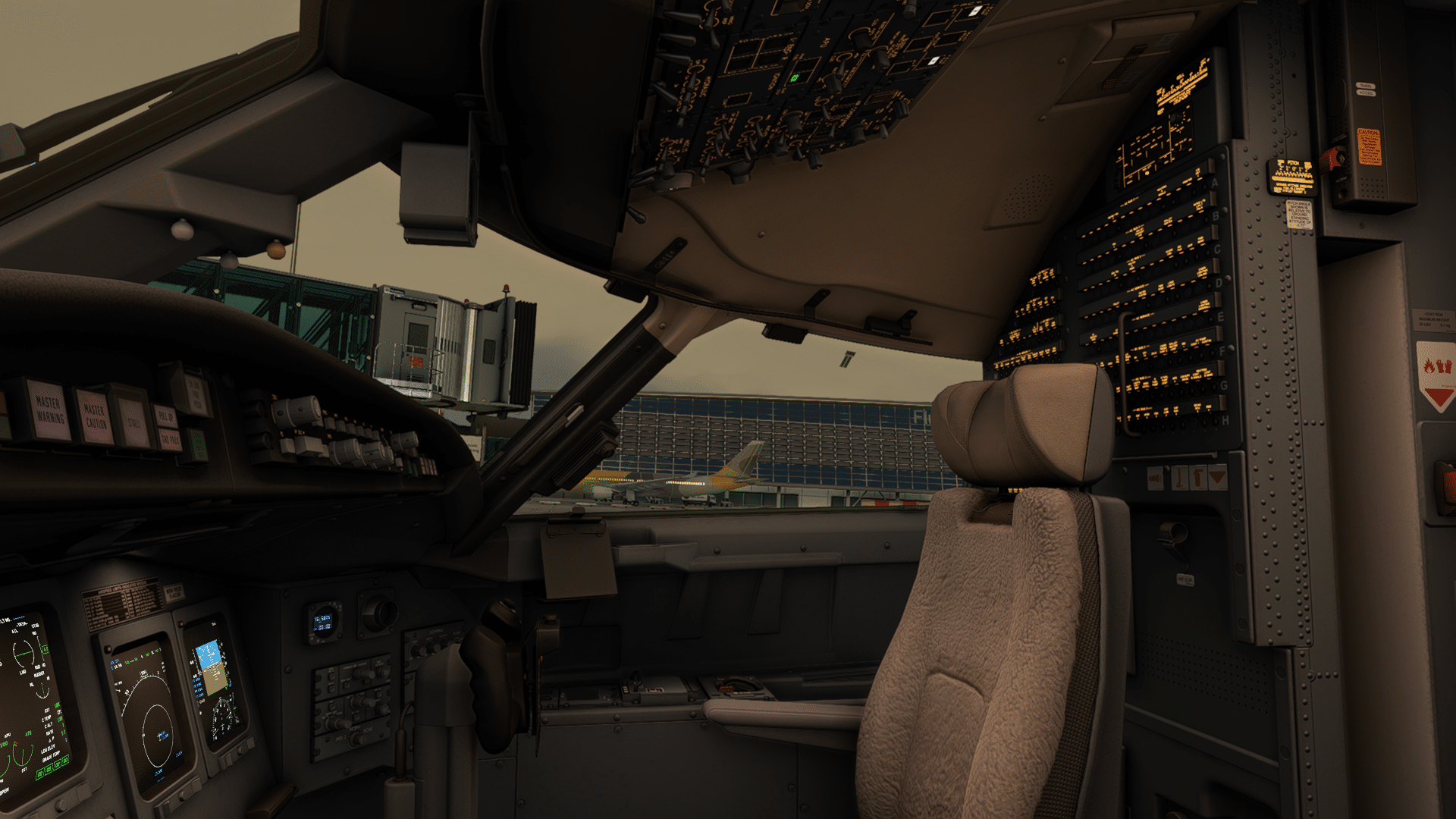
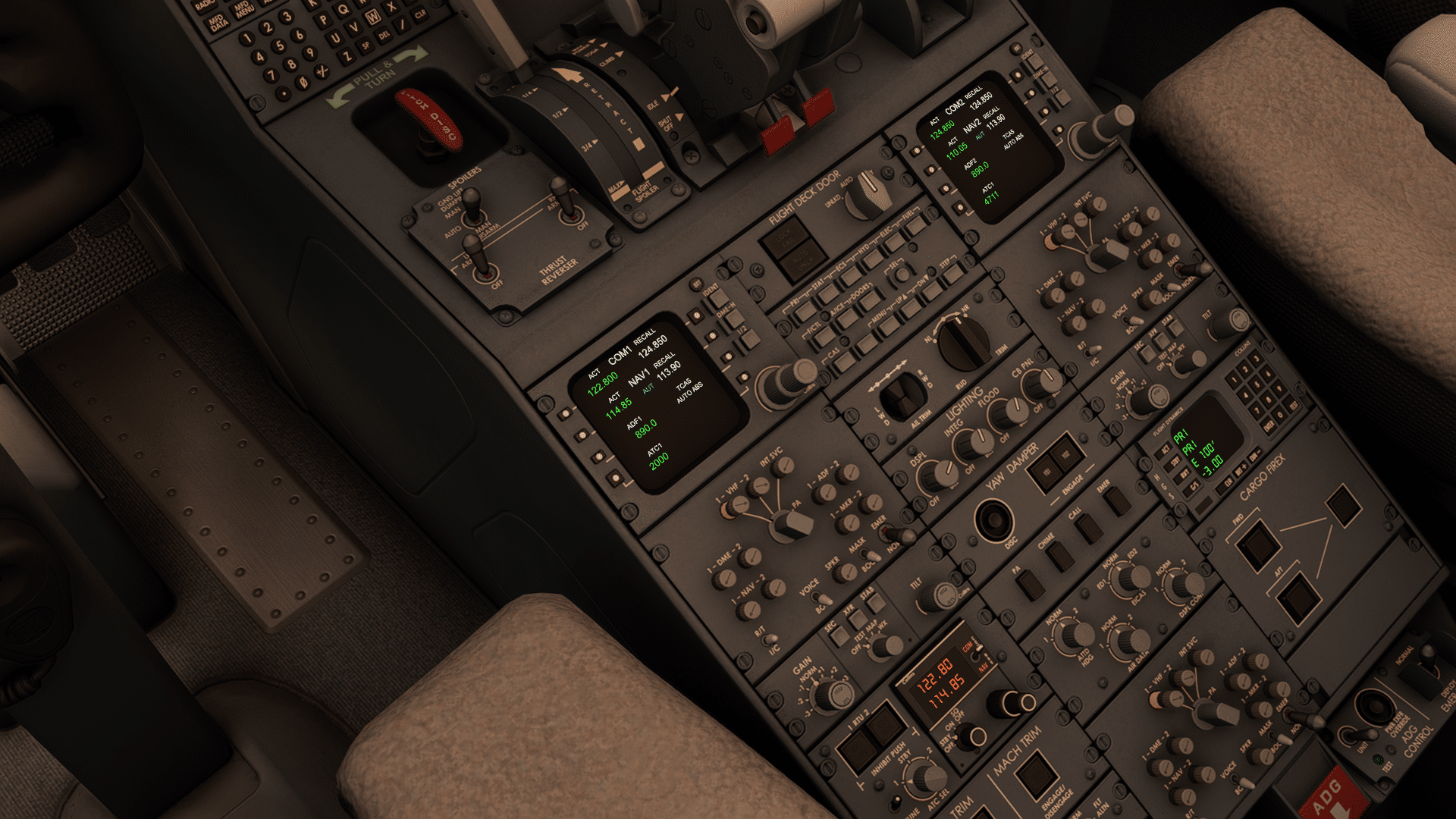
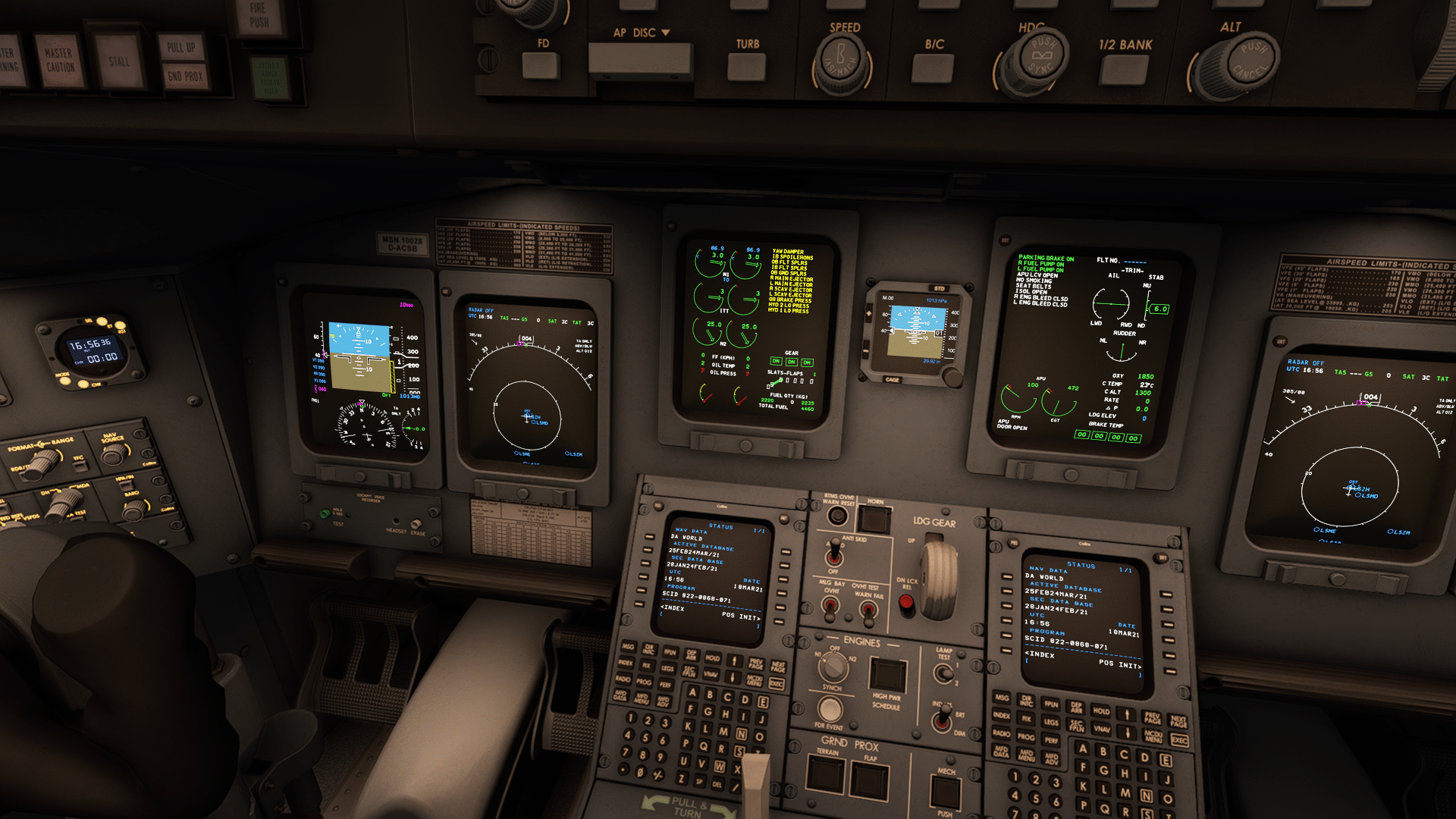
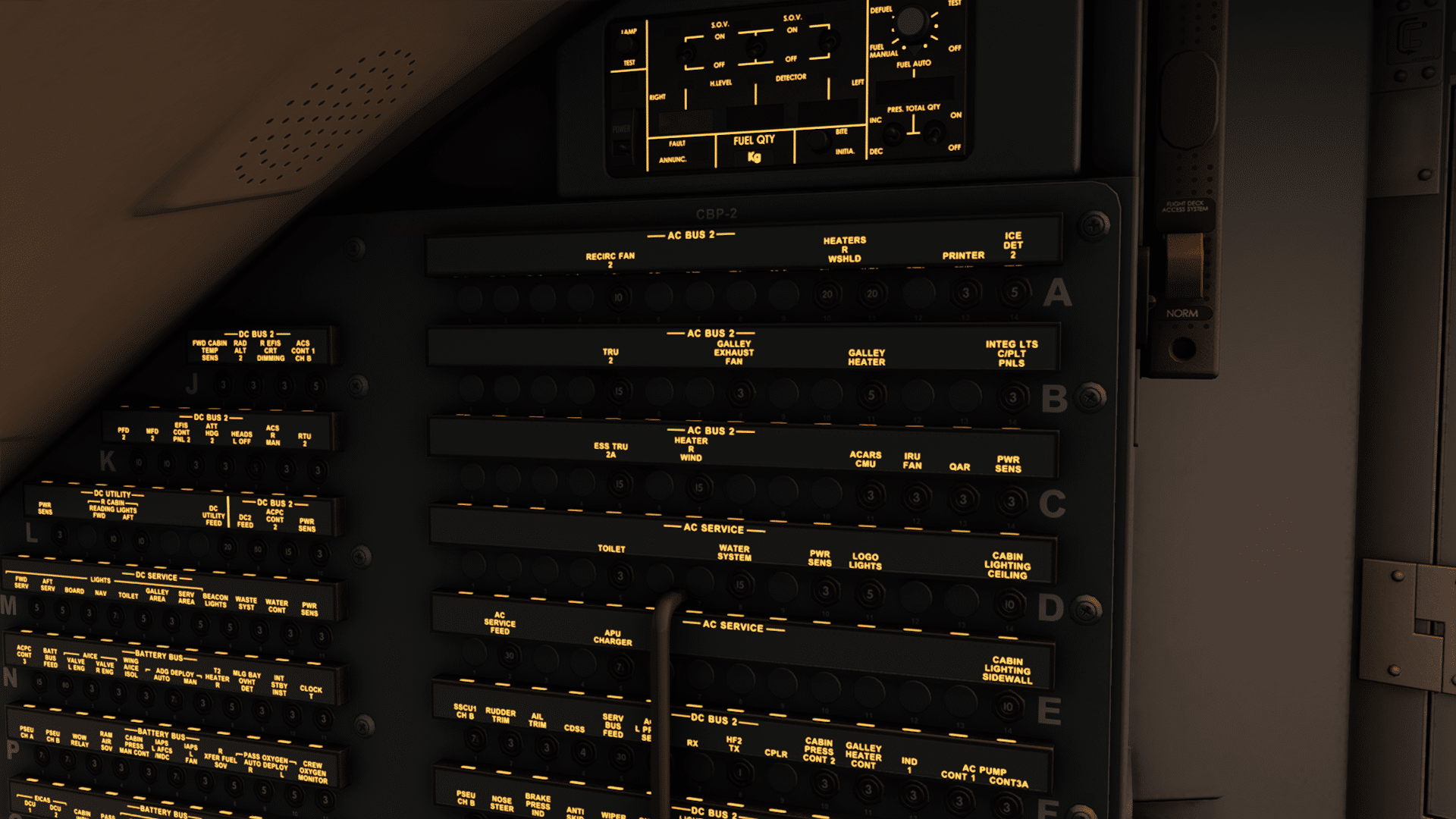
Atmospherically, the cockpit shows itself to be a bit old-fashioned with the small screens, the many switches and dials. Sim enthusiasts are happy about that, because there you still have to think, touch, readjust while flying … to engae AP on Fl 350 and sit back for watching is not possible. Something like that was really missing in the MSFS!
Optically, then, the first complex airliner in the MSFS is a successful showpiece, exterior and interior, with a few minor blemishes.
Flight characteristics (Patrick)
A simulation model is a representation of reality. In which simulator software a model runs is a technical question, but in the end the flight behavior should always feel the same if implemented well. And because this is the case, I only need to refer to our above mentioned review of the “first” Aerosoft CRJ for FSX/P3D, because our former editor Tom described very well, in detail and worth reading, how the CRJ flies (unfortunately only available in German). And since the developers have done a good job – it still fits today – in principle.
However, we don’t want to make it quite that easy for ourselves – after all, we have collected our own impressions, and enough of them. Even more, the MS FS is a different simulator in terms of operation, performance, virtual reality. Let’s say we summarize and add.
Flying by hand
The first time I flew with a CRJ was from Düsseldorf to Gothenburg. That was my first ever flight on a smaller aircraft than the usual Boeings and Airbuses. I still remember the agility of the aircraft, I didn’t know it like that. “Sporty” was the word I had in mind at that time. And that’s how the CRJ flies by hand in the simulator: it rolls very quickly around the roll axis, is even almost a little unstable, and falls into the turns quite easily, like a sports motorcycle. And it’s pretty nervous around the pitch axis and actually needs trimming very often. If you haven’t already, put the trim on two buttons or knobs on the joystick, better yet on the control yoke. Without proper trim, attitude requires full concentration, but you also need concentration for managing speed, especially on traffic patterns or any transitions from climb to descent on level flight. Fortunately, at least I got used to the handling of the aircraft after a few flights.
One peculiarity: the CRJ has its engines – like DC-9/MD-8X and Boeing 727 – above the wing plane. Engine thrust therefore creates a pitch-down moment, when thrust is removed this moment vanishes, and as a result the nose goes up slightly. Tom had already described this effect in his “old” review. It’s not particularly noticeable, but it is indeed the case that soft landings work completely without flare (pulling up on the yoke), simply by pushing back hard on the thrust levers at the “30 feet” announcement. I didn’t find landings too difficult, I did have to pull a little harder on takeoffs than usual in other planes.
Flying on autopilot
The CRJ’s autoflight system consists of the pitch control modes “Speed” (hold a specified speed using pitch, the pilot controls thrust to adjust vertical speed), “Vertical Speed” (hold vertical speed, the pilot controls thrust to adjust airspeed) modes, “Attitude Hold / Select” (hold altitude, or capture a pre-selected altitude from other modes and then switch to hold altitude) and “Approach” (fly off ILS) as well as roll control with “Nav” (follow a route in two-dimensional space) and “Heading” modes. As also known from the Dash 8Q400, Nav control works either with VOR navigation or with the FMS as source.
The NAV mode is similarly powerful as in other airplanes – a programming of the flight path in the plane including SIDs and STARs is possible, there is even a “secondary flight plan”. I had no problems with following the route, and if I did, then I was the fault – I just had not clarified various “discontinuities” between SID, route and STAR.
There is no speed control by auto thrust, but there is – again similar to the Q400 – a Full Authority Digital Engine Control, i.e. a FADEC. It works like this: To take off, push the thrust levers to the TOGA position, they engage, and thrust is automatically adjusted correctly. Runway too short? Push the thrust lever further forward to the “Max Power” detent. For climb flight there is the detent “Climb”, and only in level flight (cruise, altitude constraints) manual control is used. This is actually quite comfortable, even such finesses like take-off with reduced thrust via “assumed outside temperature” are known to the FMS, the thrust for the TOGA detent is then adjusted accordingly. On the following picture you can see the markings on the thrust levers:
What is not possible with this concept, however, is the precise flying of a given path in space. There is at least a rudimentary vertical navigation (“VNAV”) as an aid for this. Vertical navigation works in such a way that from the “Top of Descent”, which is calculated by the FMS based on the approach route, cruising altitude and altitude constraints, the system displays a “diamond” in the primary flight display. The pilots’ task is now to use the “Speed” or “Vertical Speed” modes to ensure that this “diamond” always remains in the center of the display. At least at the beginning, it will rather not.
So what can’t be done is just watching while flying – this requires not only monitoring, but also activity. And actually, I enjoy it more – flying Airbus is sometimes more like going to the movies.
My experience: when using the autopilot, maintaining or adjusting airspeed is challenging. My standard route in the simulator takes me from the 14L in Cologne via Bonn, Nörvenich NVO and the Radial 039 to the Rhine and back to the 14L. It is always difficult when there are altitude changes, because climbing and descending flights require an adjustment of the thrust. Not only once did I miss the ILS approach to the 14L because I was busy adjusting heading, VOR frequency, altitude, flaps and thrust. And also in cruise flight it is important not to go too fast and not too slow, but there is still some time to observe the landscape. And that’s exactly why I’m happy about the CRJ – finally an airplane with which all the great airfield add-ons make sense, and with which I can enjoy the great scenery on the way.
Realism vs. Difficulty
Michael: Two hands and two eyes are not enough to get everything right at the right time: in critical flight phases you have your hands on the yoke and thrust lever (and you can’t take them away either), the view outside and on the instruments (thanks to HUD this even works together). Two more hands are missing for flaps, dials, switches, radio … and two more eyes are missing to always look exactly what you are doing on the panels, because the click spots must be hit very precisely (while the effect of the adjustment is displayed somewhere else, e.g. autopilot settings such as altitude, heading, VS). During the familiarization phase, the autopilot also relieves little, because its correct operation demands so much attention that easily something else gets out of hand while you turn the cog.
Overall, the plane requires a lot of familiarization and precise operation. This is great because it’s realistic – and at the same time demands frustration tolerance. Especially beginners are quite “taken” here, until something works satisfactorily, you need a lot of prior knowledge about technical systems in the aircraft, navigation and flight planning. And even then, the logic is quite different from that of Airbus or Boeing, and even experienced simmers have trouble with the operation of the plane. The forums are currently overflowing with disappointed “error messages” … often due to operating errors. So in view of the steep learning curve, it would make sense to include different difficulty levels, from “sit in and fly off” to get pleasure from the machine, up to the Study Level (for example as “type rating missions” or analogous to the beginner level with Aerosoft’s Huey in FSX)?
Patrick: Well, but where should you start? What actually works quite well is to set the aircraft condition to “Ready for Take-Off”, then set flaps, apply thrust and take off. From my experience, it always gets difficult when thrust control is essential, i.e. when descending. This is quite a chase of the “diamond”, which indicates the vertical deviation in VNAV mode. So flying would be simplified quite a bit by a VNAV mode and thrust control, but that’s just a different plane. But I definitely agree that it can get stressful in the CRJ.
Michael: At least linking to the MSFS own help systems (checklist, copilot) could be useful, and also that flight plans are transferred from MSFS to FMS! The manual entry of the waypoints into the FMS is only something for super-enthusiasts, even in reality pre-stored company routes are loaded – to avoid errors (very easily there are mistypings in it and a waypoint lies on a different continent) and to slim down the turnaorund work in the flight deck.
Patrick: I absolutely agree with you there. I actually found it really good on my flights with the A320 mod that the route, which was put together with the not even that bad route planner of the MSFS, was also loaded directly. No long clicking around, no searching on tables for the right SIDs and STARs, the simulator does it all. In this respect it would be really great if the route could be taken over. Maybe this will be possible in the future. For the beginners, but also for the after work pilots with little time.
Other Things (Patrick)
Performance and Virtual Reality
The performance of the CRJ is excellent. Even with my slightly older Nvidia GTX 1080 and the – also older – Oculus Rift, the view in VR only flickers when clouds come into play, otherwise the simulator runs smooth as butter.
The CRJ seems very vivid to me. Michael had already written it – in VR it stands out even more: You can practically feel the narrowness of the cockpit, every now and then I was involuntarily afraid of hitting my head on the HUD. I rarely had such a feeling in simulators. I am happy to accept the weaknesses of VR here: Not only are the monitors relatively small – the writing smears a bit and is therefore particularly difficult to read. This is possibly due to the optical simulation of CRT monitors, but makes it difficult here. And: the indications for altitude, heading and airspeed are usually far away from the corresponding buttons, which makes adjustment difficult. My workaround: altitude and speed can be read better on the HUD, and for heading the indication on the display is sufficient. It’s difficult especially when flying manually, with autopilot it’s easier. And leaning forward helps (towards the displays). Maybe it would be a possibility to be able to adjust the fonts on the displays a bit sharper, but maybe it’s time to think about a replacement for my Rift, unfortunately.
A little tip at this point: the middle mouse button can be used to latch buttons, for example rotary knobs. Then the mouse wheel will rotate that exact button, no matter what the mouse does or where I look. This makes flying in virtual reality much easier for me.
Concept for operating the plane in the sim
The first version of the CRJ in FSX and early Prepar3d versions already had an operating tool in the cockpit. Here it is now an iPad that is used to operate all functions outside the actual cockpit, i.e. doors open, aircraft status, thrust lever calibration and so on. There are also checklists here and the ability to set the load and transmit V-Speeds and Reference Speeds to the aircraft. All in all, a very user-friendly option – immersion is maintained, great especially for VR.
Small bugs that the CRJ still has
As said above, this list here is relevant for the release version 1.0.0.0 of the CRJ, but at least I had the chance to check the change list of the update to 1.0.0.1, and the points I summarise here seem not to be included in the update.
All in all, the plane is also relatively free of bugs. However, I would still like to mention a few bugs that will most likely be fixed soon:
- The flaps cannot be operated by joystick axis. First, the entire flap range from 0 to 30° is reduced to a very small part of the joystick axis, and even if you then hit the right position with a lot of sensitivity – the flaps do not move. Workaround: operate flaps by mouse, this works quite well even with mouse wheel.
- Not a mistake, but maybe one or the other stumbles over it: the thrust axis must be calibrated, otherwise the movement of the thrust lever does not match the setting. Michael: After calibration, the idle detent is at about one-third of the shifter travel, the first third is thrust reversal. For everyday operation, this means you ALWAYS have to look closely at the thrust lever, intuitively nothing works there. This is annoying and not true to the model, you have the thrust lever travel “in your wrist”. Maybe Aerosoft comes up with something better (e.g. clearer clicks for the idle position?). Patrick: Well, I did without the thrust reversal on the lever and put ‘Idle’ pretty much to the real zero position. Then it goes easier with the operation, but without thrust reversers. What the heck, I don’t wear out brakes in the simulator. But just also not realistic.
- The subject of landing gear: the nose wheel control can be turned off by switch, alone: it seems to have no effect, can be steered anyway. Workaround: not necessary, usually we do want to control the nose wheel.
- Also topic landing gear: the gear horn, as the warning sound when the landing gear is not extended, did not work for me. It simply did not come. Workaround: Think about the gear before landing. Or follow the checklists :).
- The view is not quite correct after centering in virtual reality, you sit slightly between the chairs. No drama – Workaround: arrow to the left to adjust the own position.
- Sometimes I had the problem that the NAV mode of the autopilot has not captured VOR radials, partly that the station is displayed only on VOR 2 and not on VOR 1 at all. But it may be that this has to do with not running the simulator as administrator initially, as Aerosoft recommends.
By the way, I did not have the dreaded crashes to the desktop (CTD) on any of my test flights.
Conclusion (all)
We both think: The CRJ is a great airplane that, from the point of view of us hardcore simmers, brings Microsoft Flight Simulator forward tremendously. It allows great after-work flights over the great scenery display, and with great performance (on our computers, see below). Especially, but not only, in VR it’s a great experience to fly this complex jet through the simulated world, and very satisfying to execute a flight as planned.
The software still has minor bugs, but no “showstoppers”. Stably it runs today already. For just under 50 euros it is again cheaper than the aircraft addons in the other simulators, and we wish Aerosoft that many newcomers to flight simulation will use this software to kind of become hardcore simmers. From us there is a clear buy recommendation!
What could stand in the way of this somewhat: Operating the CRJ is a bit stressful even for us who have experience with system-deep addons (keep in mind: in reality, there are always two people sitting in the cockpit, we’re on our own). Hopefully the – positively speaking – steep learning curve is not too steep and frustrating. Fortunately, video tutorials help there – the included literature sufficiently explains how to operate the aircraft, but is not quite easy to work through.
Informationen
| Pro | Contra |
| Great exterior model. Stable software, detailed and realistic simulation of the Bombardier CRJ, the first system deep payware commercial aircraft in Microsoft Flight Simulator. | Small errors, but no showstoppers. Steep learning curve. MSFS help not implemented. Realistic error tolerance, it is “zero”. |
| Test Systems | |
| Developer: Digital Aviation & Aerosoft Price: 49,99 € in simMarket | Michael: IntelCore i5-10600K CPU @ 4.10GHz, GeForce RTX 3070, 8 Gb Windows 10×64, 16 Gb RAM, some SSD Patrick: AMD Ryzen 5 5600X @ Stock Speed, Oculus Rift CV 1 GeForce GTX 1080, 8 Gb, Windows 10×64, 32 Gb RAM, some SSD |
Dr. Michael Kalff, Dr. Patrick Seiniger
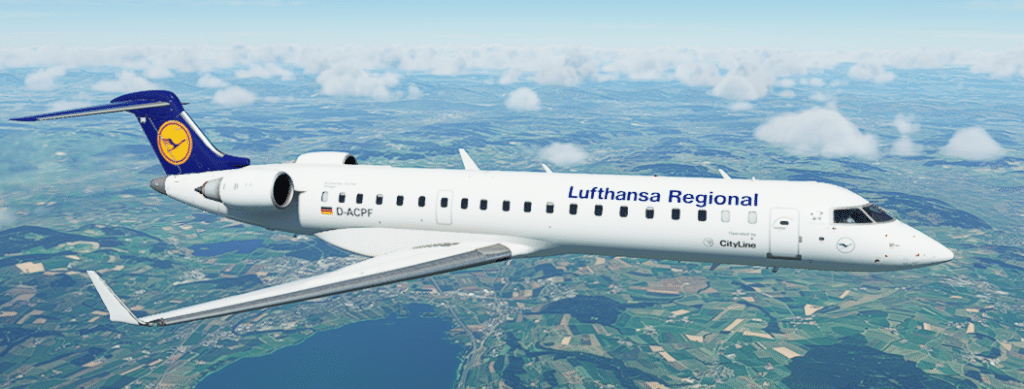
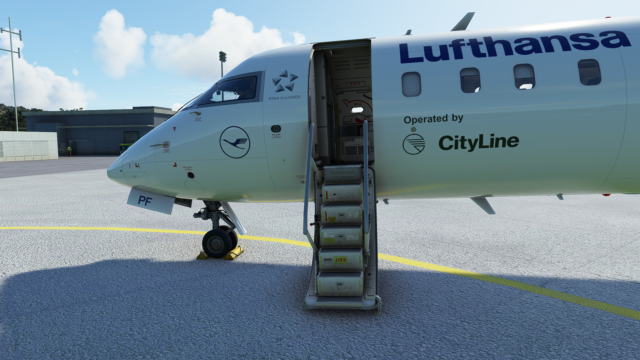
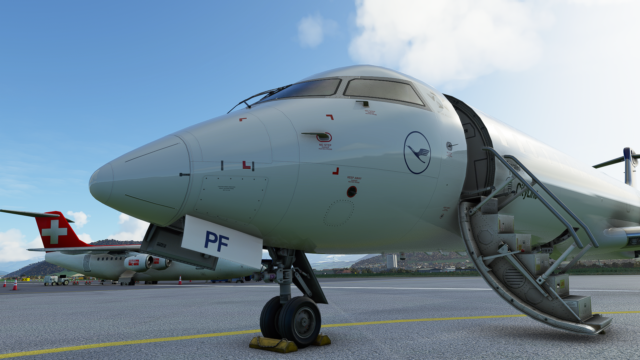
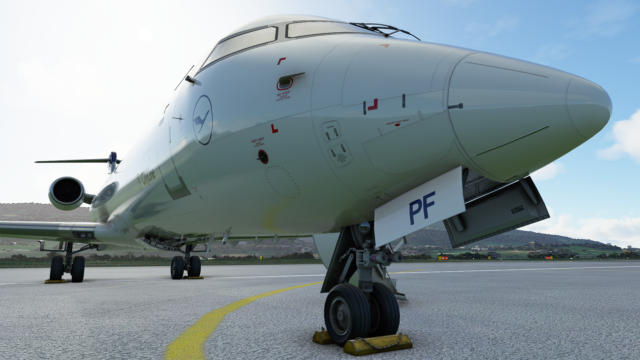
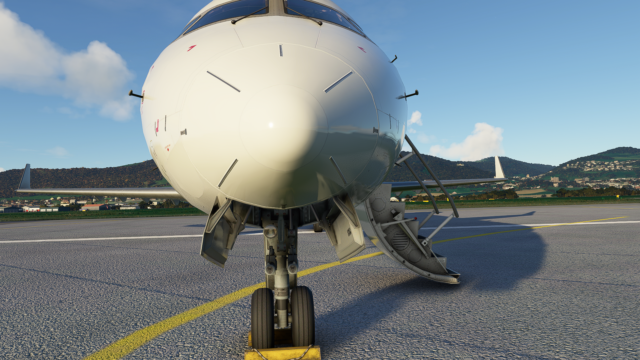
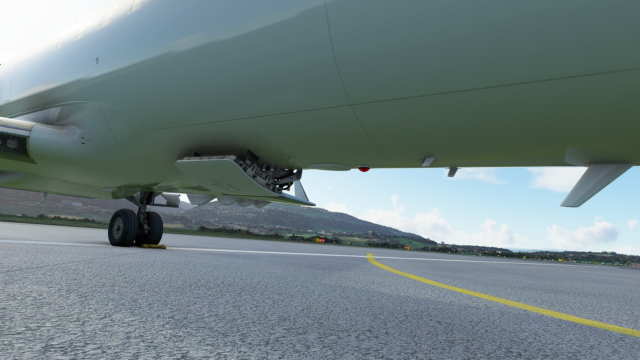
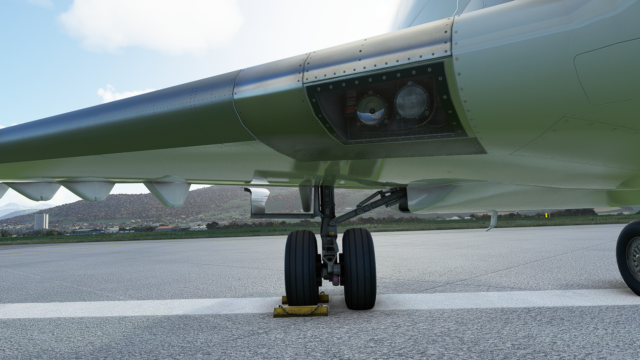
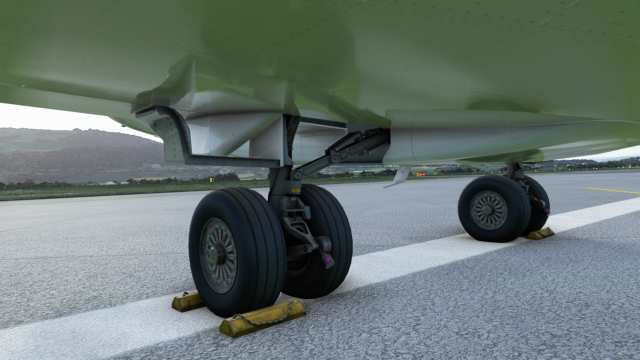
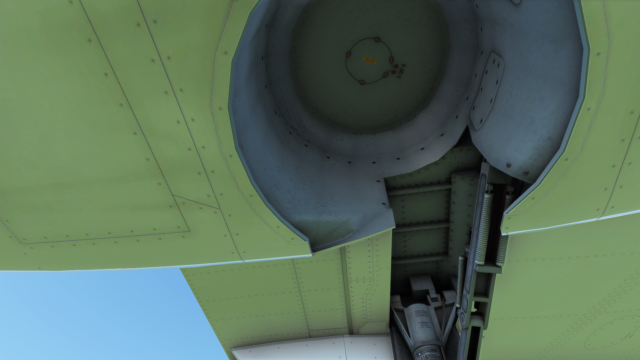
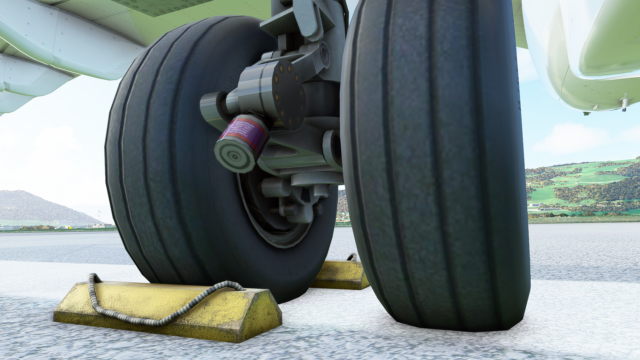
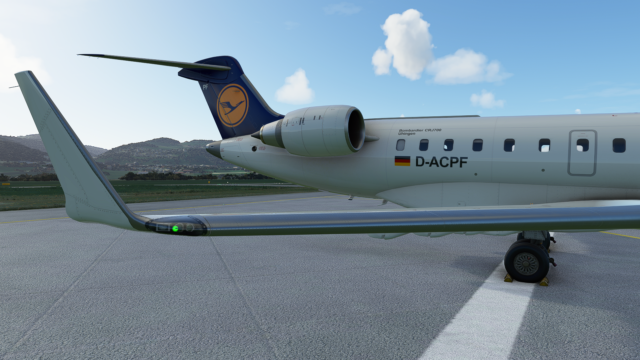
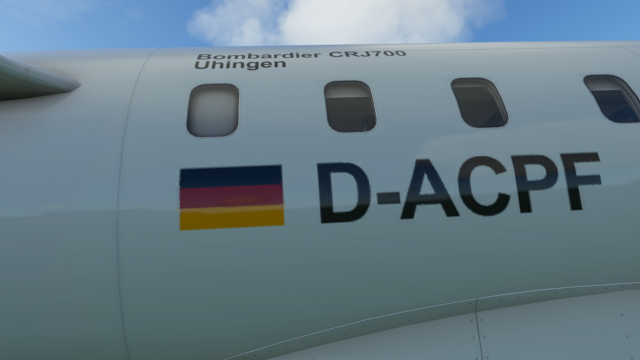
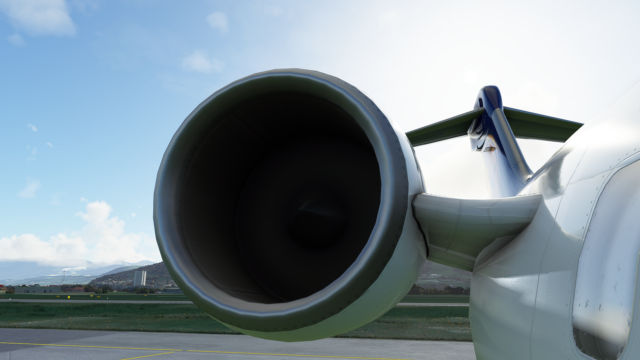
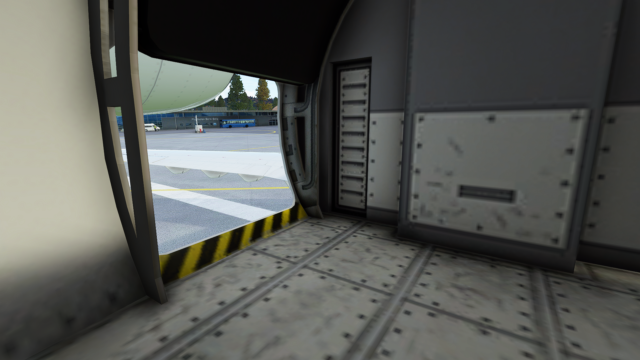
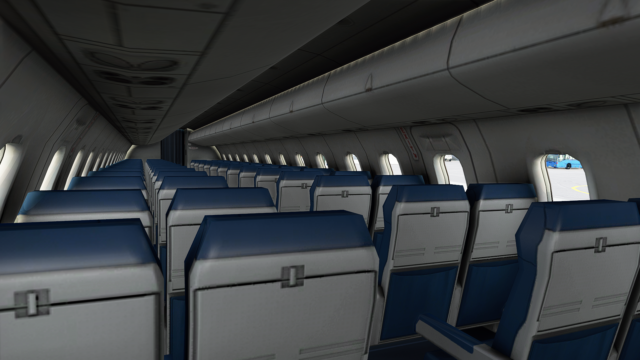
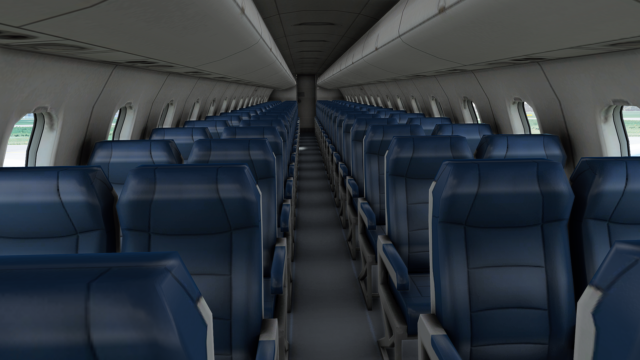
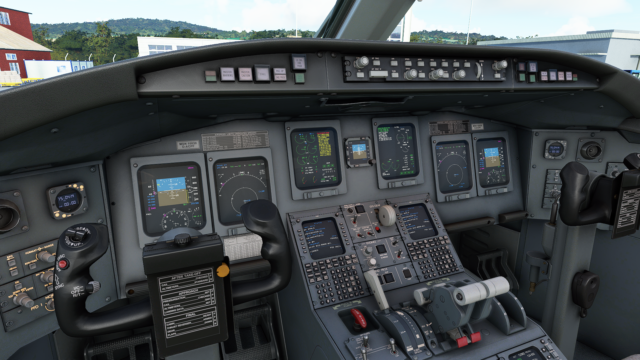
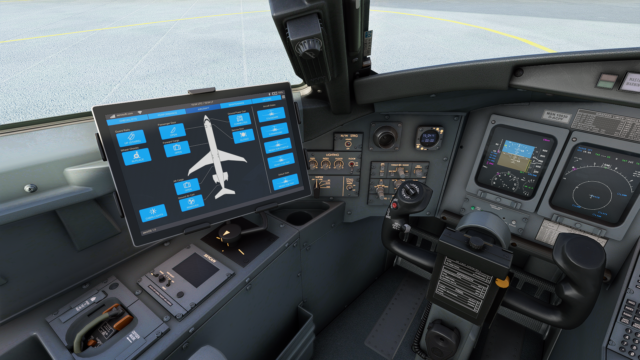
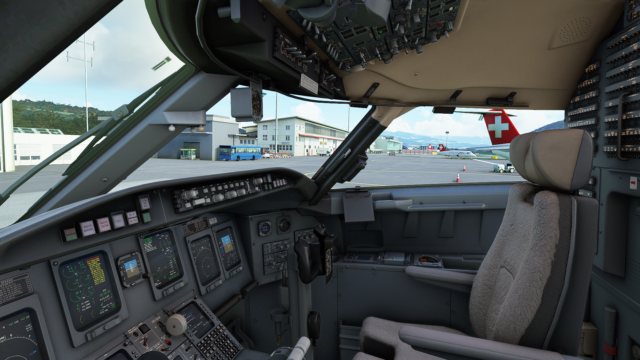
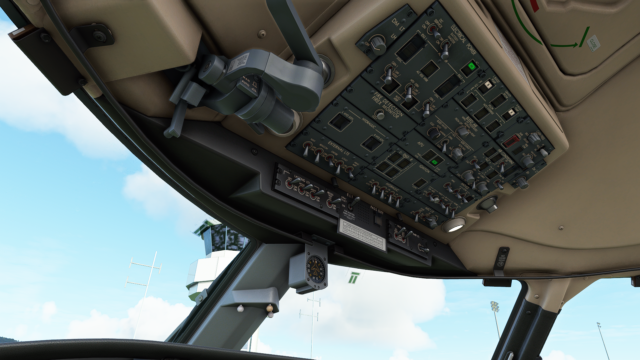
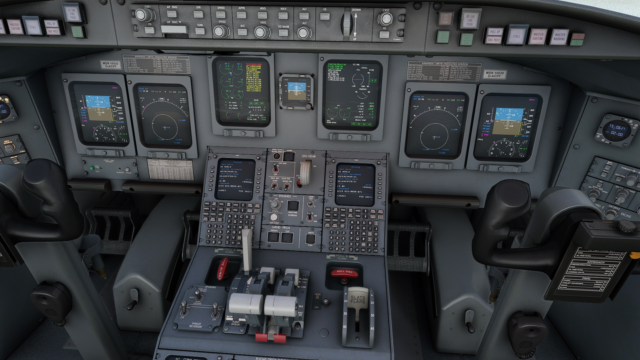
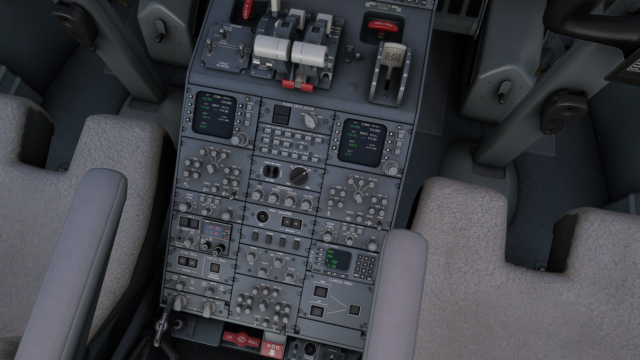
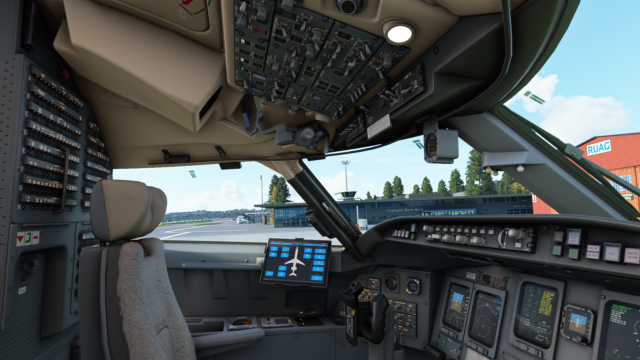
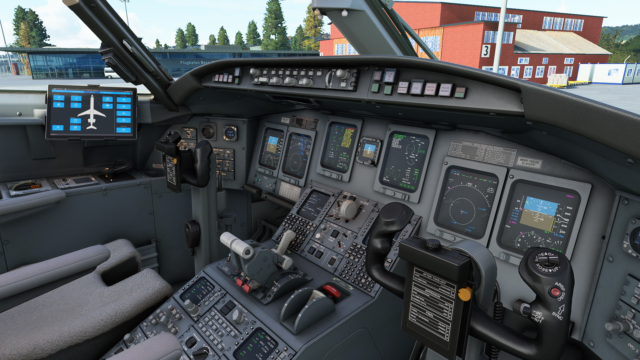



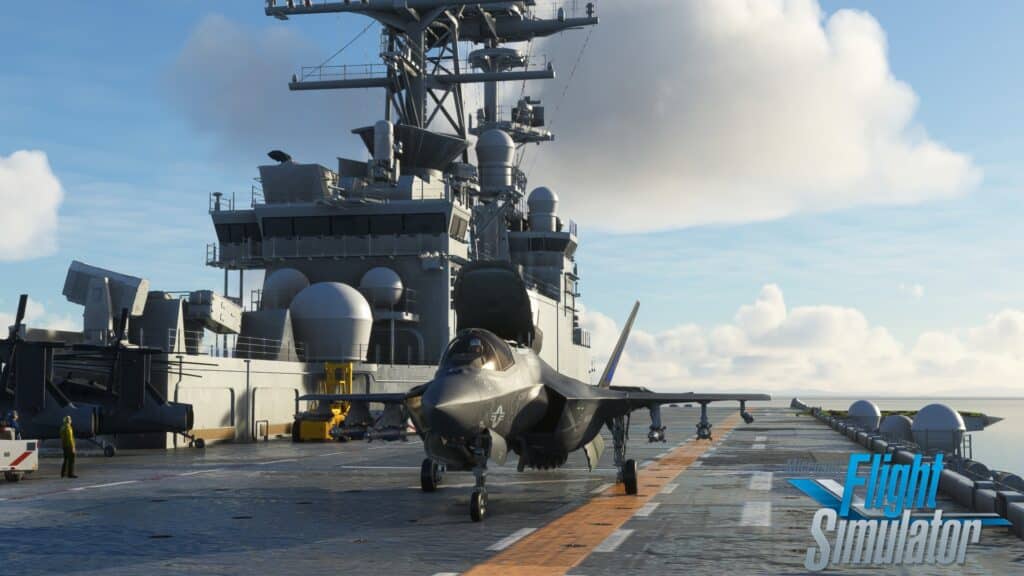
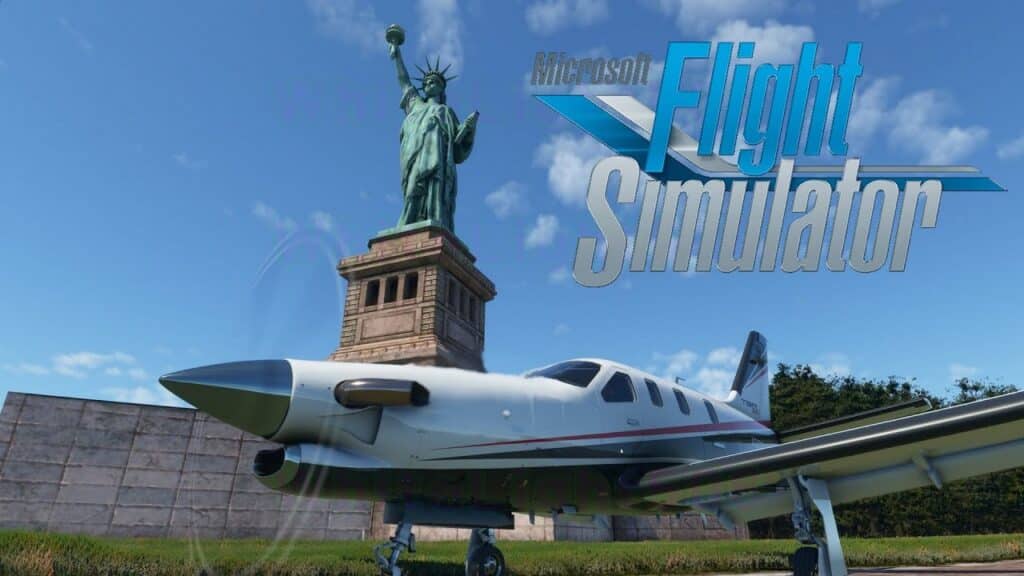
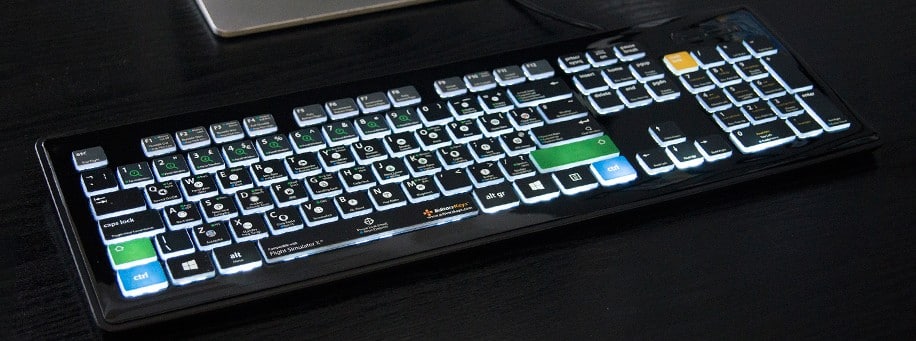
![[Video] Fly The Maddog MSFS | Systems Trailer | 4K](https://www.simflight.com/wp-content/uploads/2023/01/Maddog_systems_thumb-1024x576.jpg)
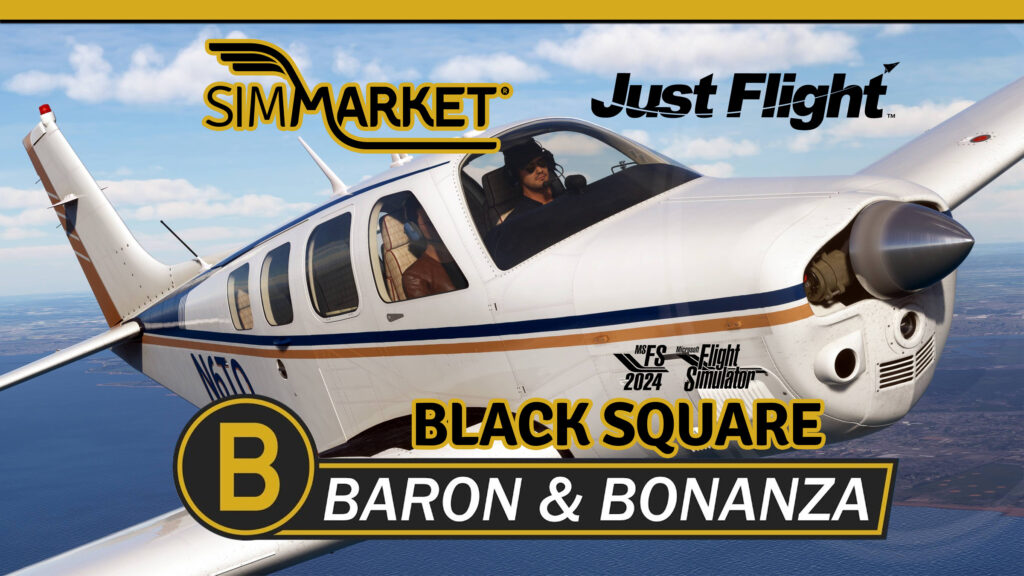
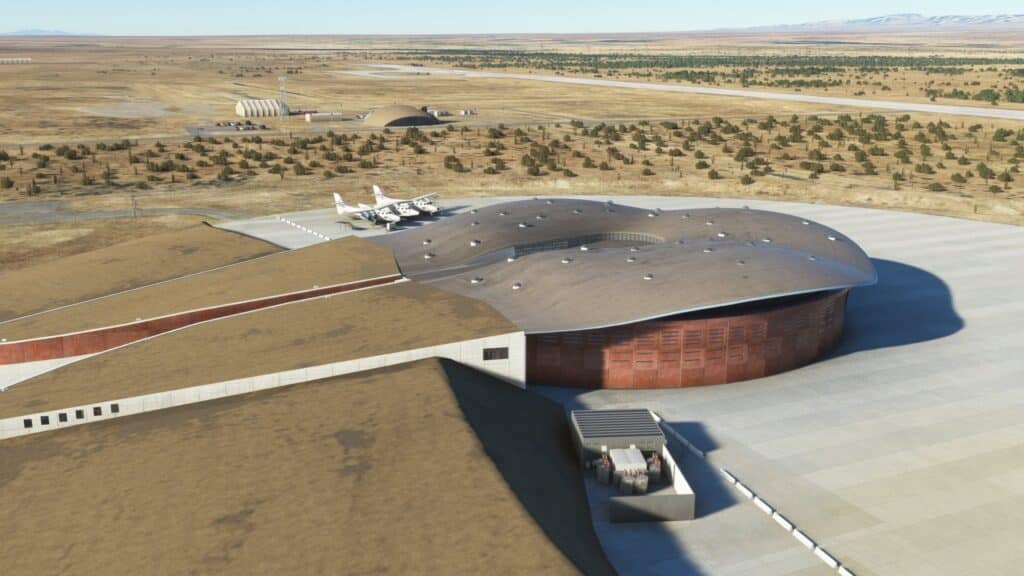
Great visuals… I have been trying to start engines for the last 48 hrs, multiple freezes. Cant do much. I have a crazy fast computer. Might have to wait for a patch tio be able to get off ground.